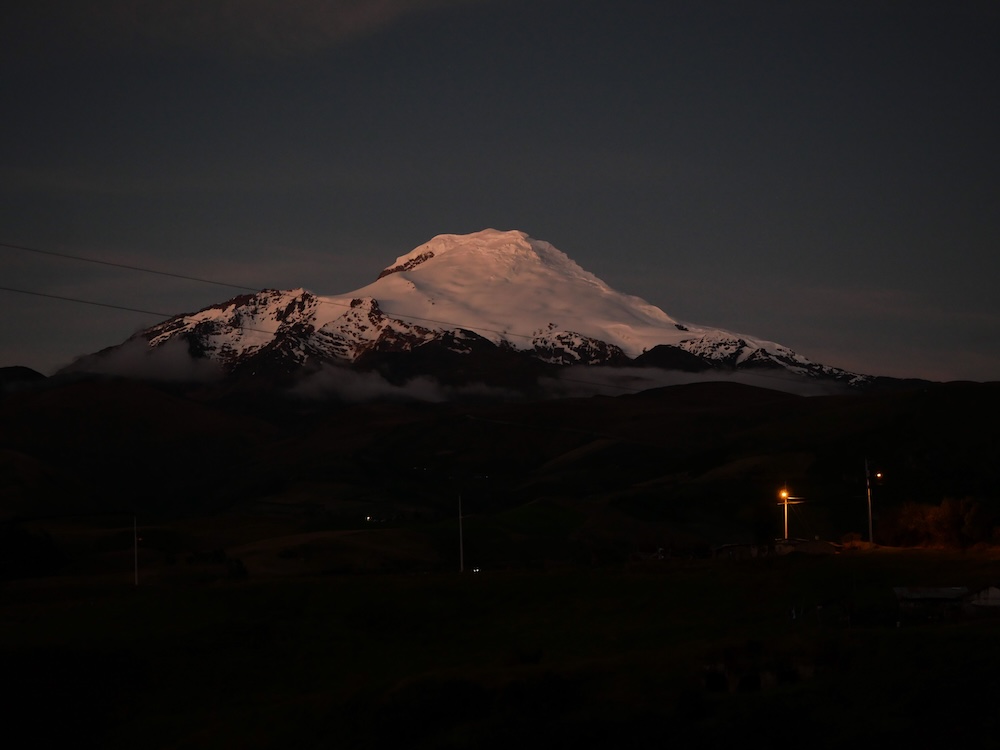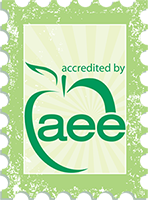2025 Ecuador Semester Blog #3
Welcome back to the Ecuador semester blog! Since the last update, we have left Palugo, biked through the Andes, had hard days and beautiful days, and ended up in San Clemente, where we were immersed in life with our host families. Some of it can’t be captured in words — but I’ll do my best.
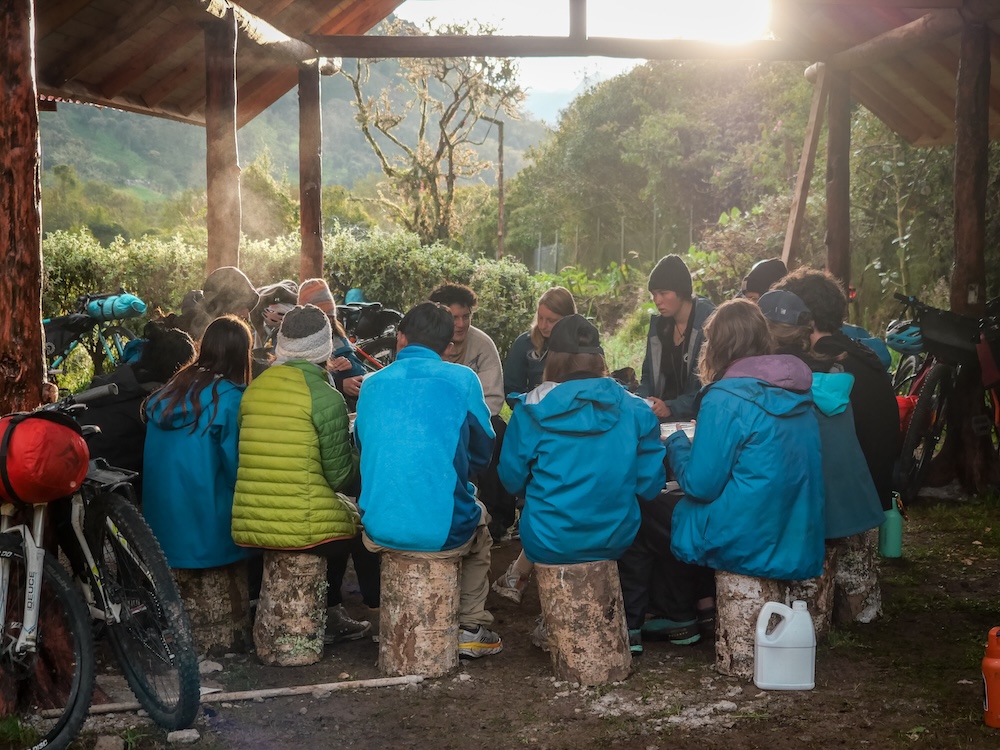
A note on the current situation in Ecuador from Lindsay and Ella:
The political situation in Ecuador is complex, as it is in many parts of the world. What we’ve learned is that the Indigenous Kichwa (Quechuan) communities here continue to face systemic inequality and have fewer rights and resources than much of the population. In the coming month, the president is expected to propose changes to the constitution that could further reduce the protections and support these communities currently have.
Most Indigenous communities are located in the northern Andes — the same region where we’ve spent much of our time — and they’ve been organizing peaceful protests to defend their rights and preserve their way of life.
At the same time, the Ecuadorian president’s recent and drastic increase in diesel prices (which is expected to lead to overall inflation) has sparked widespread and powerful demonstrations across the country, including in Otavalo — right near our destination of San Clemente. With military involvement and the unpredictable nature of large protests, the situation has occasionally become tense.
The team at Palugo has been carefully monitoring everything day by day to ensure safety while maintaining the spirit of adventure and learning. When we set out on expedition, we didn’t know if our final destination would be San Clemente, the jungle, or a return to Palugo. While the uncertainty was sometimes challenging, it ultimately added to the sense of exploration and resilience that defines this experience.
Our students have shown remarkable curiosity, compassion, and maturity in engaging with the realities around them — learning not just about Ecuador’s landscapes, but also about the people, cultures, and systems that shape this beautiful country.
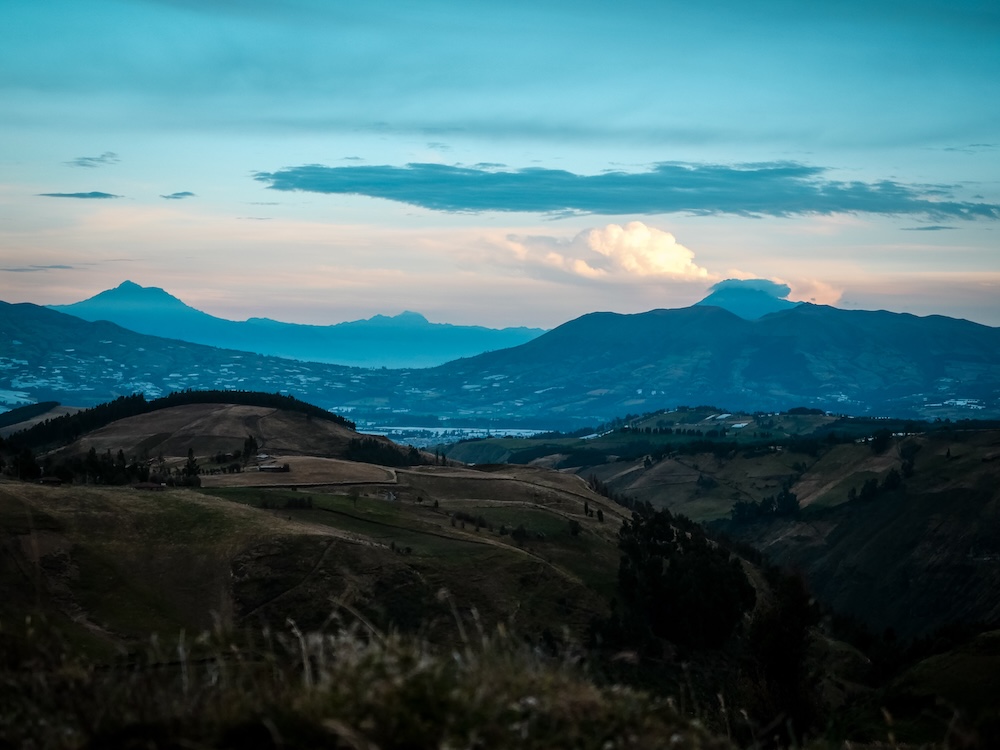
Day 1 ~ It was midday as we said goodbye to Palugo–our bikes heavy with gear and our hearts full of anticipation and energy–and set off into Ecuador! We spent all morning packing our bikes with sleeping systems, food, clothes, and group gear, making final preparations. Now we were ready to begin our expedition.
We weren’t sure how the biking would be in this new terrain and at such high elevation, but our morning runs in Palugo must have paid off because we made good time! Some people began to feel the altitude toward the end of the day, with nausea and exhaustion, but even those not feeling well were strong. After 12 km, we found our home for the night in a cow field surrounded by pines and the grand presence of mountains close by.
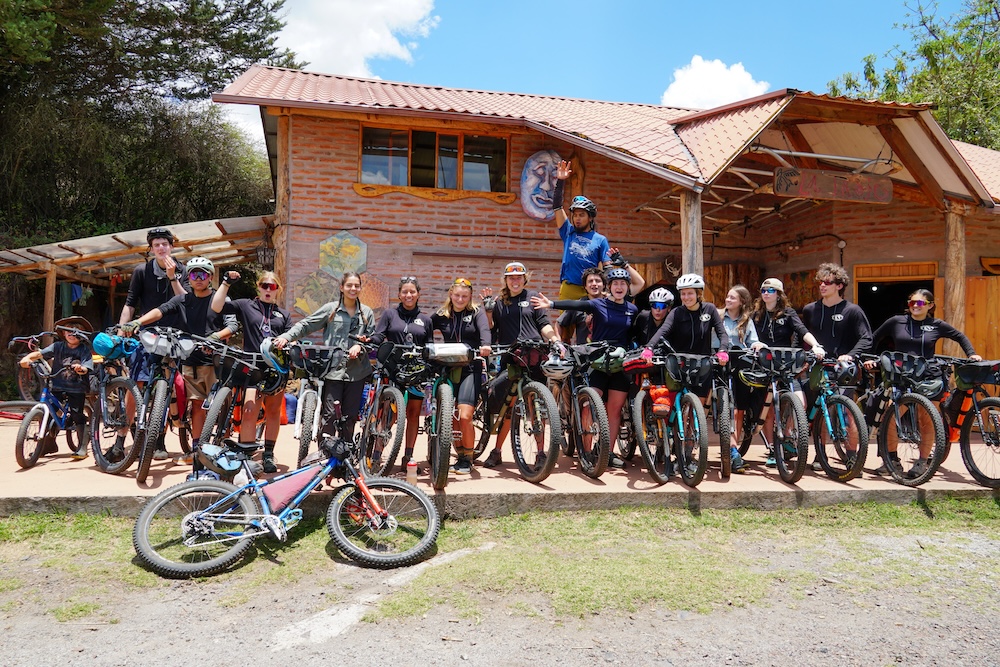
Our group ready to take off on bikes!
Day 2 ~The second day brought us higher into the mountains, past tourist gardens and flocks of sheep. We stopped for lunch in a grassy field, and some of us hiked the nearby hill while others swam in the river or watched the clouds floating by. After several more hours of uphill biking, we reached a totally new landscape: the páramo — the high mountains with mushy grasses and windswept wildflowers.
It was another day of uphills, but we began to settle into a rhythm. When all there is is uphill, it begins to feel less overwhelming. After 10 km, we found our beautiful campsite, a pasture cradled between the mountains. The terrain proved rather lumpy, but we squeezed our sleeping bags between clumps of grass and found it to be decently comfortable!
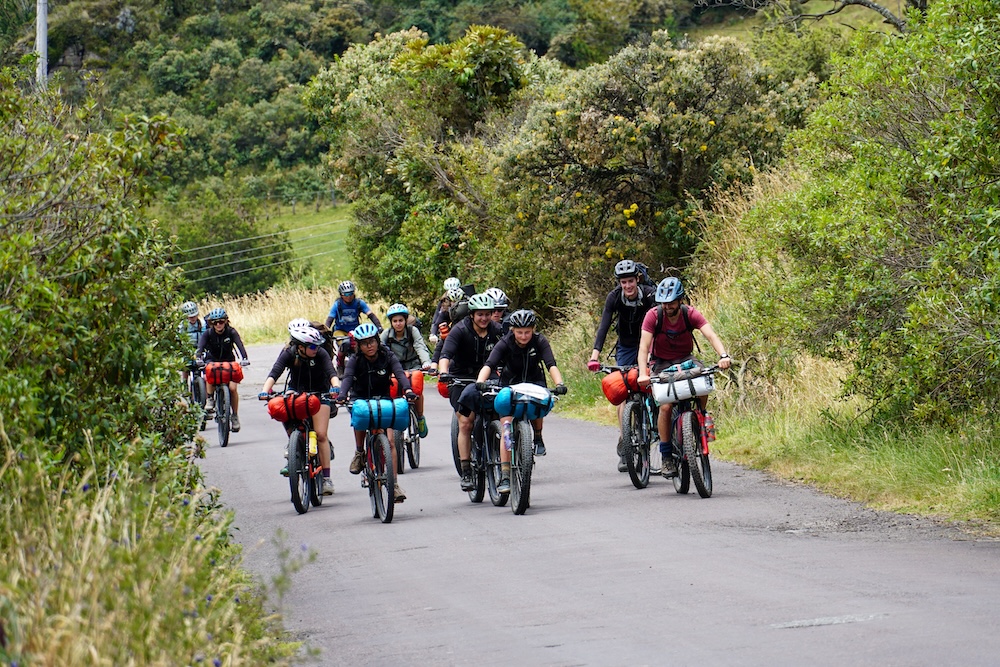
Heading up up up and then some more up….
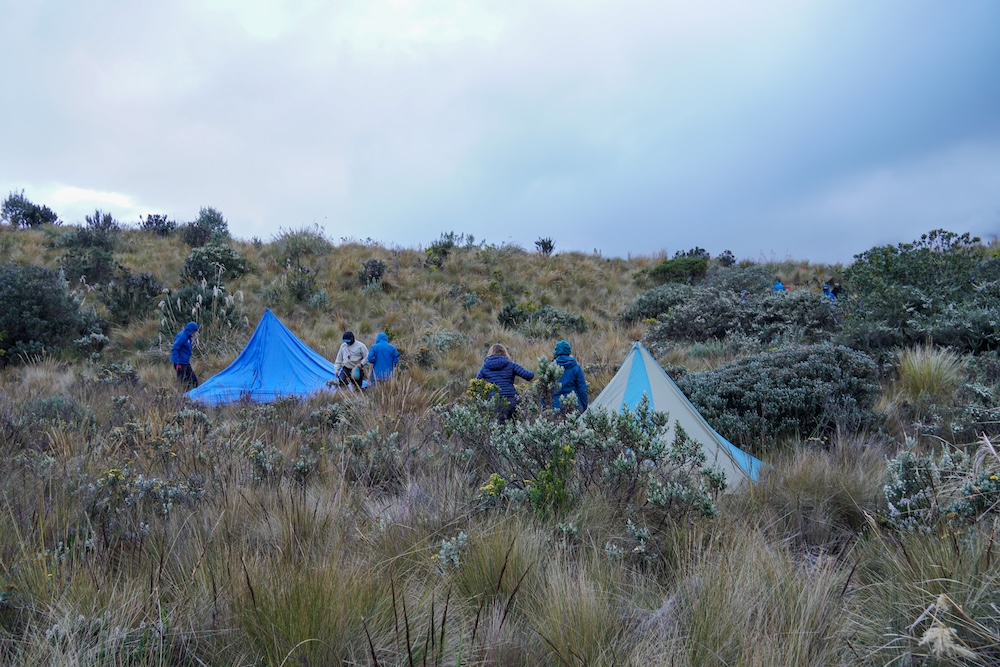
Camping among the paramo grass
Day 3 ~After two long days of uphill, we finally had our first day of downhills. After performing safety checks on our bikes, we sped down the hill through the rain and completed our short day, arriving at Diego’s house.
Diego — the father of a former Kroka student and an incredible craftsman — kindly shared his space with us, letting us camp on the nearby hill and use his kitchen and living room. He taught us about his craft: leather braiding horse bridles, whips, and lassos (one of which he once used to lasso a puma attacking his sheep!).
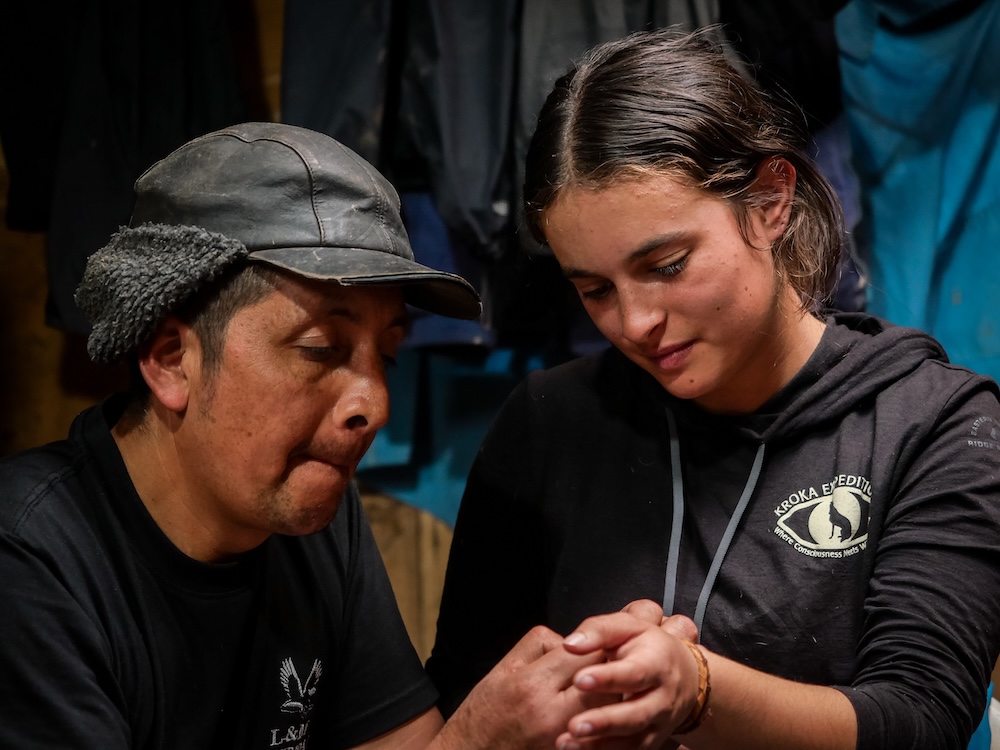
Diego tying on Clara’s bracelet
With his help, we braided leather bracelets to remind us of our time there. Even though many of us couldn’t understand Spanish, we learned the craft through watching and practicing.We are so grateful to Diego for sharing his space and passion with us, and for creating such a beautiful evening.
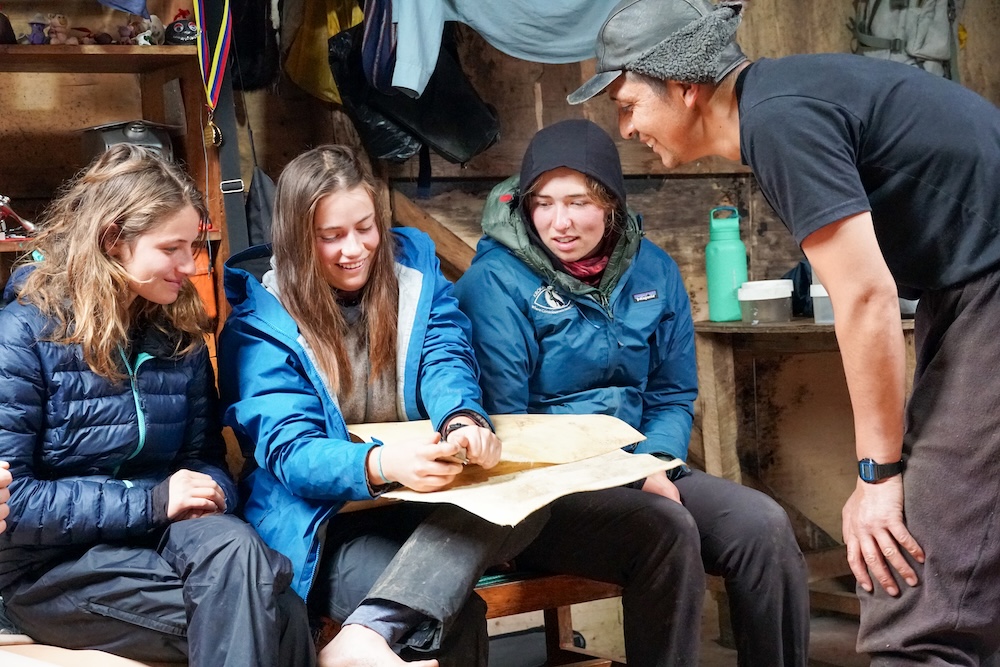
Diego teaching us how to cut the leather for our bracelets
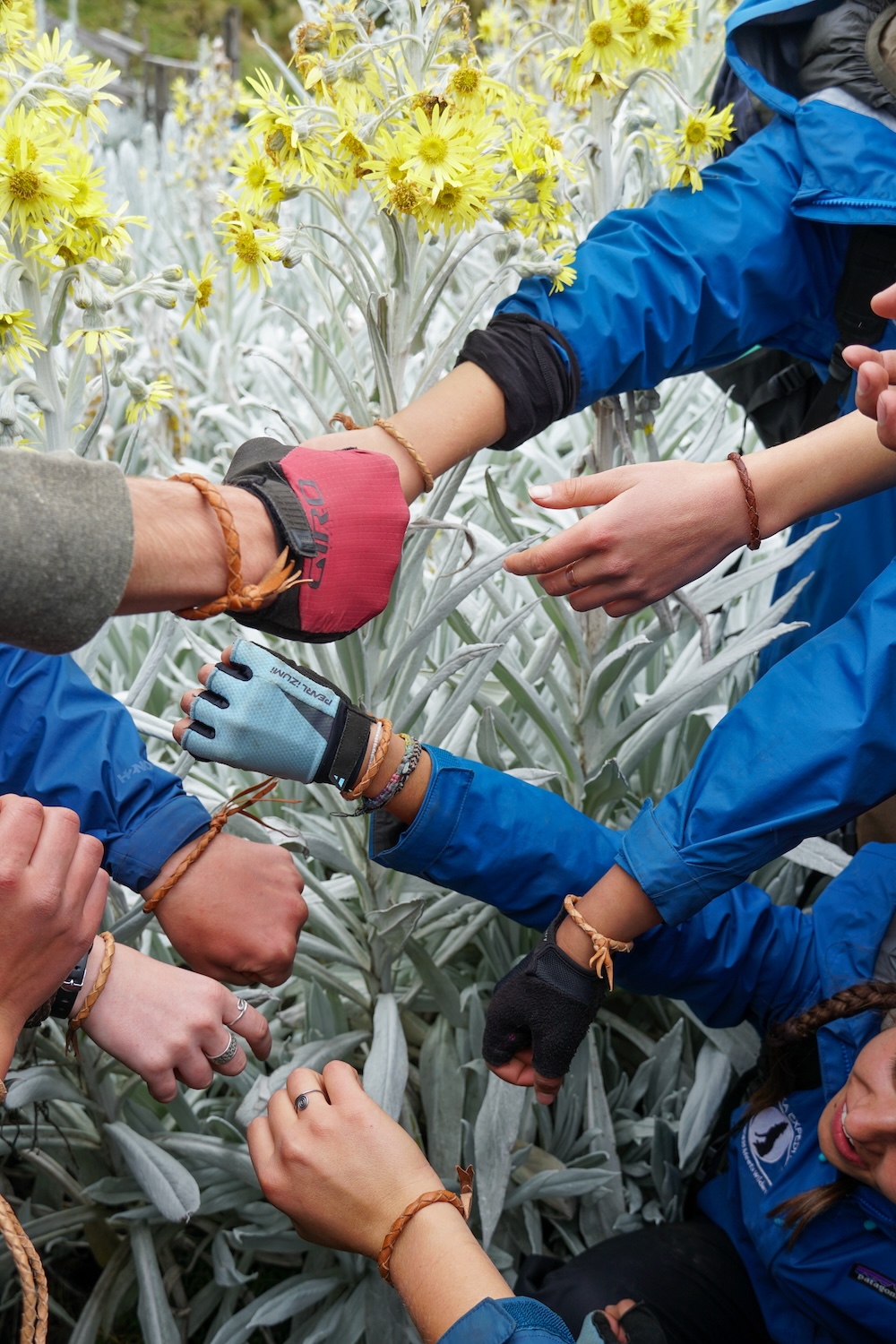
Our finished bracelets, forever woven onto our wrists!
Day 4 ~ On our fourth day of expedition, we biked with a goal in mind: Papallacta Hot Springs! After a 9 km bike ride, we arrived at the small town, set up camp, and then had the rest of the evening to enjoy the hot water. We all delighted in the hot springs and soaked our extremely sore bodies. It was a good time for relaxing and having conversations.
At that point, all of us students organized a much-needed massage circle. Afterwards, we had a restaurant dinner with a delicious soup and fried fish platter! We could hardly believe we were here on a Kroka semester…
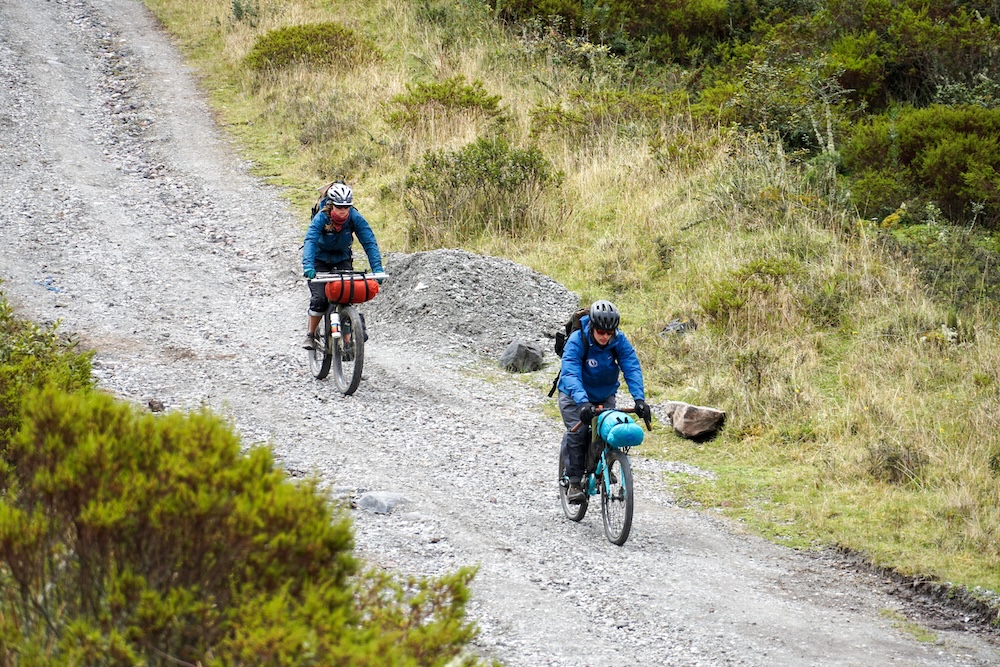
Dorothy and Bennett riding down the hill
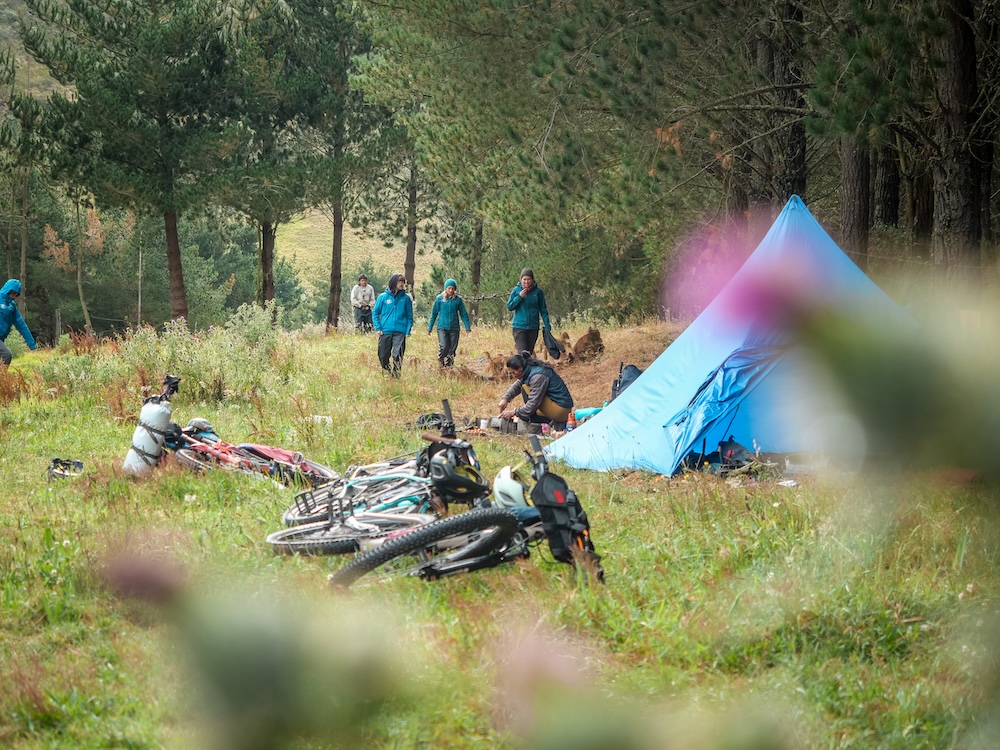
Day 5 ~ The fifth day, from Papallacta to Salvefaccha (a 26 km day), was the hardest — but also one of the most beautiful. After saying goodbye to Papallacta, we started up 13 km of hills. We started off strong after resting our bodies at the hot springs, but as each turn revealed another hill, it began to feel as though the day would never end.
Almost every single one of us struggled on those constant hills. Tears were shed, but we also found ways to keep going — singing and motivating each other. As evening wore on, we grew more and more exhausted. Some of us started feeling nauseous. Eventually, the group stopped — we were near our first campsite option and night was approaching.
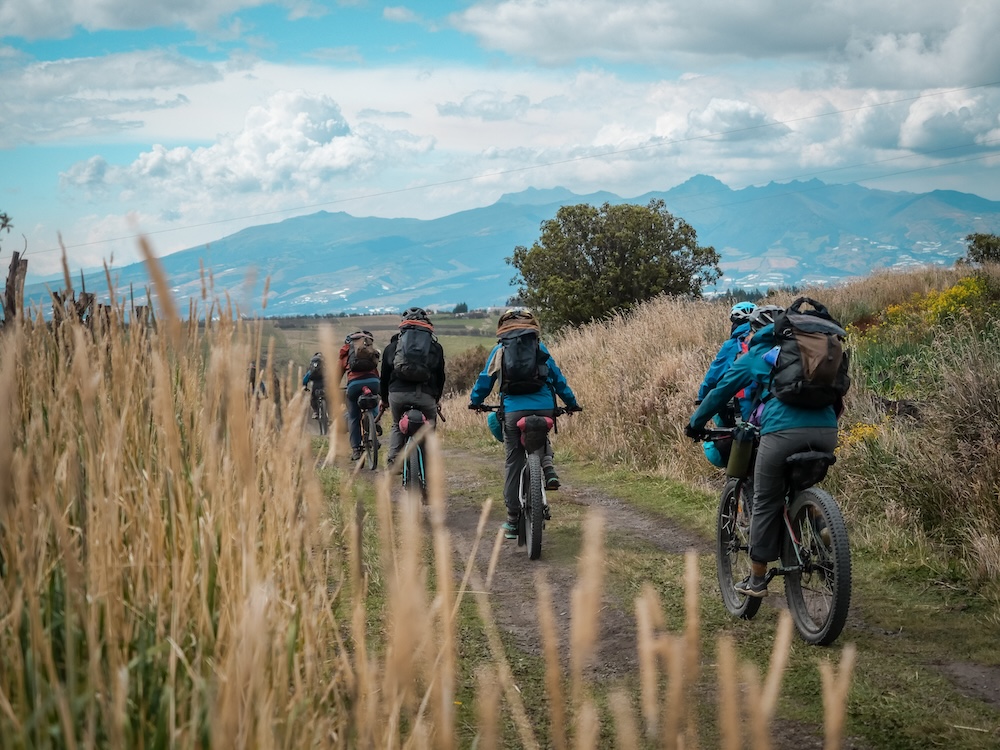
The instructors let us vote on whether to stop at the first campsite or keep pushing to the Salvefaccha Water Guard Station, where we’d have a warm place to sleep. “Who wants to stop here?” was greeted with silence — and the vote to push was unanimous.
With new energy, we kept biking. Some people began to feel more sick, but others took their backpacks and gear. As we pushed up a steep hill, we heard gasps and shouts ahead. Past the grassy hills around us, revealed behind the clouds, was Antisana — the mountain we will be climbing at the end of our semester!
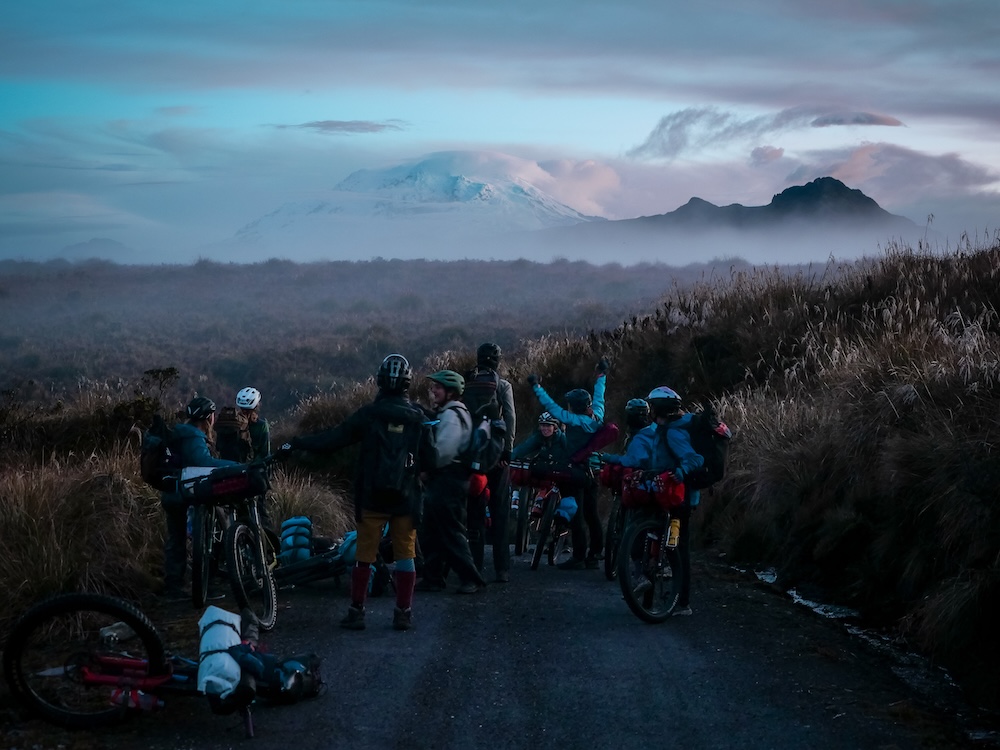
Antisana, in all her glory, motivating us to continue on
The snow-capped peak had come out from behind the clouds to greet us. Night fell and we turned on our headlamps. Finally, the roads began to slope downhill and the uphills became more gradual. Our lights shone in a little line along the road, mirroring the bright moon overhead.
Usually, we shouted “Car up!” when there was oncoming traffic, but tonight we called “Cows up!” as we biked through (and were briefly chased by) a herd of cows grazing on the side of the street. Finally, after our last uphill, we arrived at our destination: a guard station, where the guards kindly let us spend the night.
We were so happy when we reached the end that we all hugged, and a few people cried. It was such a hard day — we pushed our bodies to their limits, but they kept going for a dozen more kilometers. There were also so many beautiful moments, too. It was an expedition day that we will all remember for a long time to come.
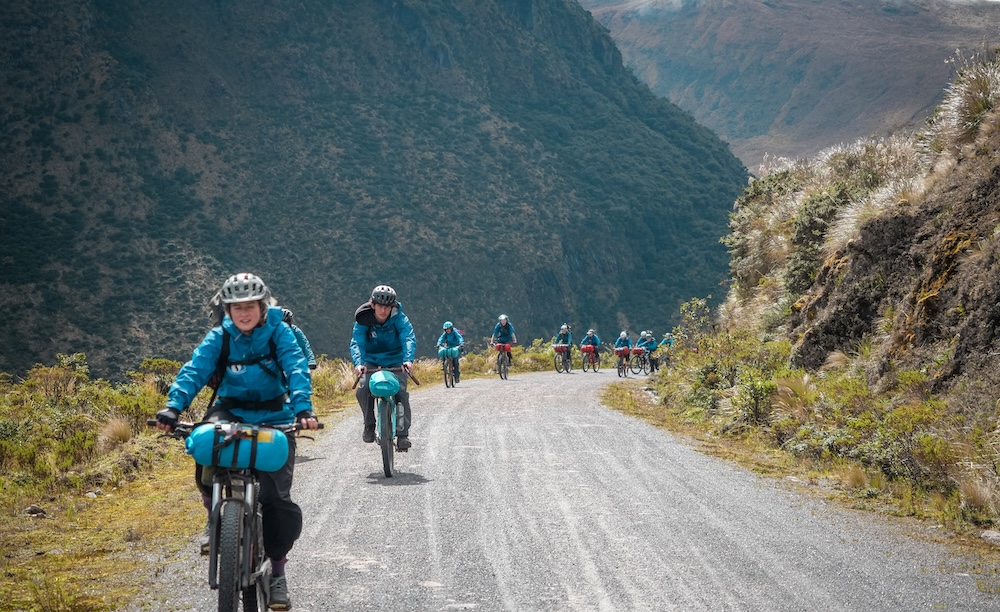
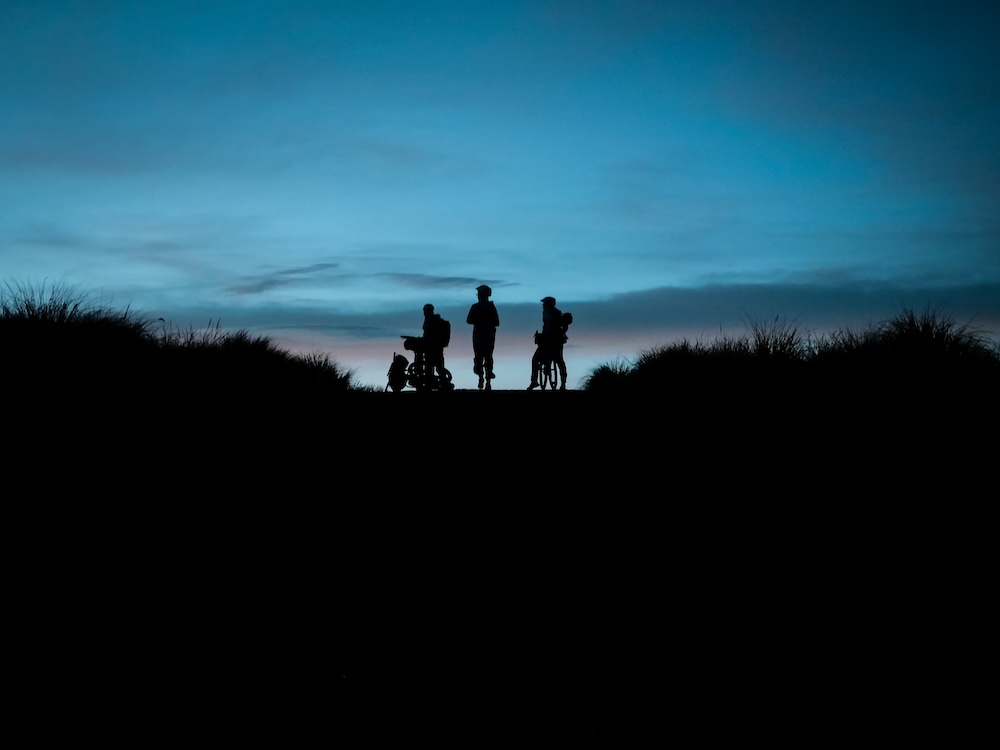
Grace, Lore, and Lindsay riding into the evening dusk
Oyacachi ~ After another short day of downhill biking, we descended into the town of Oyacachi, where we would stay for the next three days. Oyacachi is a beautiful little town near lots of protected forest. The town is also home to natural, mineral-rich hot springs!
We could hardly believe our eyes as we saw our campsite for the night — a grassy field right beside the gorgeous hot springs. There were even water slides! That evening we enjoyed the hot springs, laughing in the pools, dipping quickly into the cold pool, and testing out the slides. For dinner, we were treated to another delicious restaurant meal.
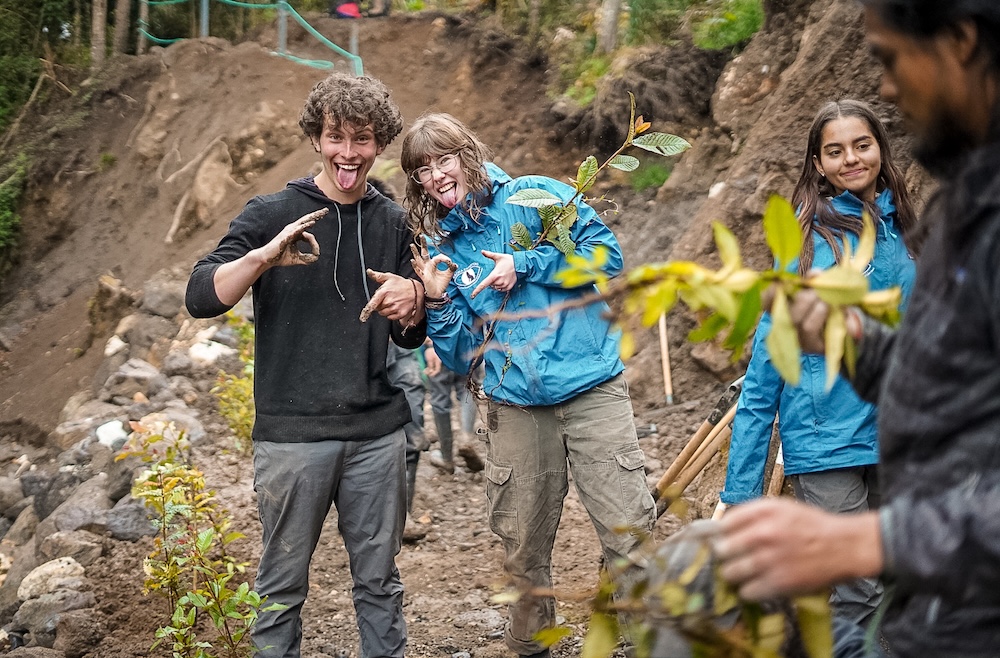
Bennett and Alaya during trailwork
The next day we learned more about the town with a short history lesson and a tour of local crafts. In Oyacachi, many people make beautiful things from wood, including bowls, artistic wood burnings, carvings, and spoons. We got the opportunity to work with two local craftspeople and make votas — beautiful oval bowls traditional to this area. It looked so easy as we watched the experts, but we soon realized it takes a lot of skill and time to do what the craftspeople did. However, we each made a bowl with only a few chipped edges and one hole through the bottom! Afterwards, we ventured to the hot springs for a few hours — our sore bodies appreciated the hot water and relaxation.
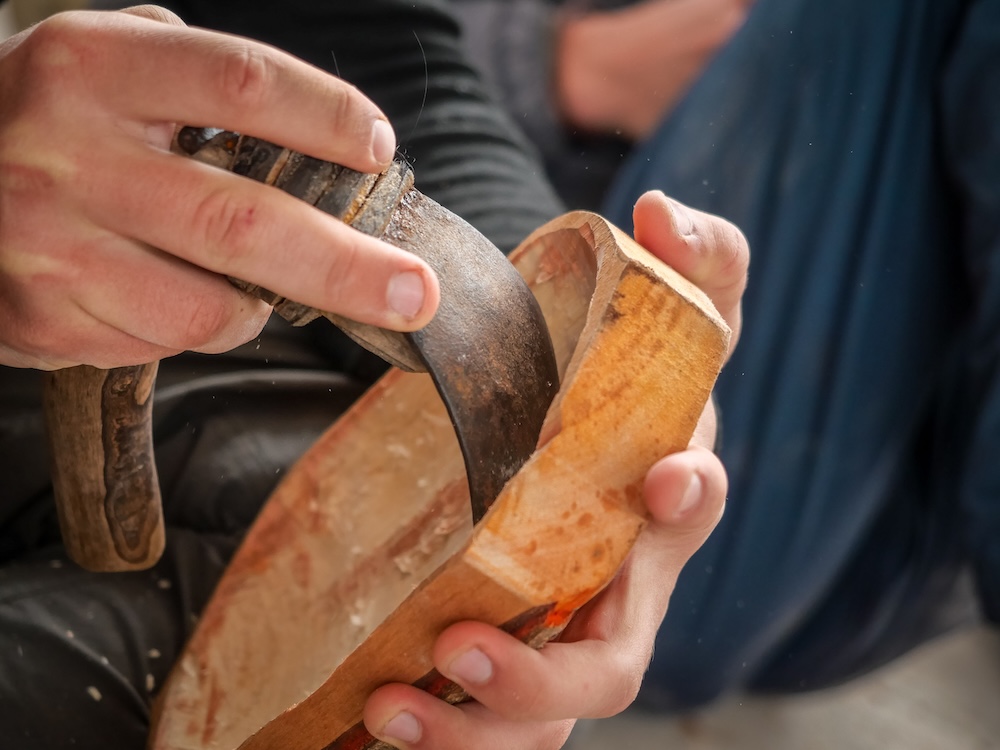
Oyacachi was a wonderful time for resting, catching up on academics, and enjoying each other’s company. This time struck a perfect balance between our long, hard days and fun relaxation. Up until the final day in Oyacachi, we did not know if we would be returning to Palugo or going to San Clemente, so we were all delighted to know that we could continue to San Clemente as originally planned. Refreshed after our spa retreat, we said goodbye to Oyacachi and continued on our way. On our final day, we spent the morning planting native trees along the Oyacachi hiking trails and river as our service work for the town.
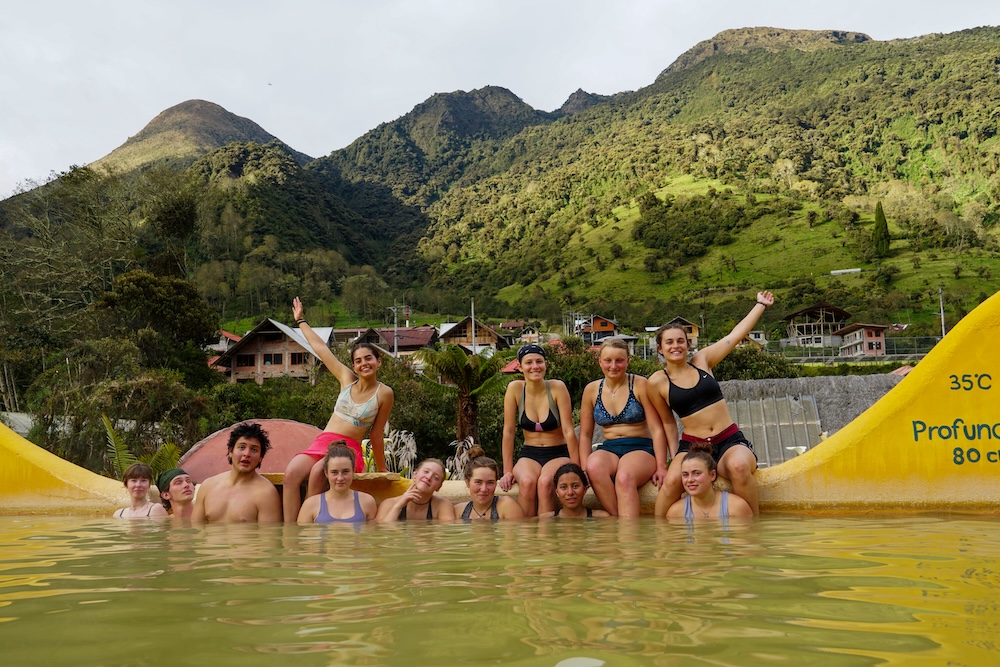
Enjoying the hot springs
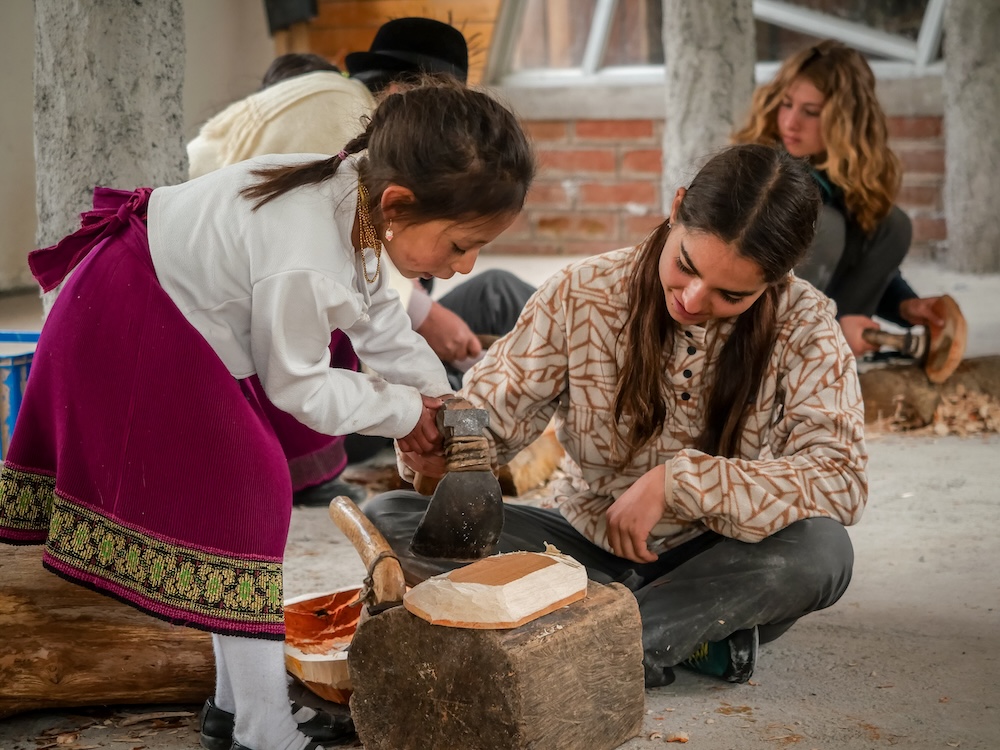
Grace getting a little help from her friend
Powerful moments for our group:
Alaya: We’re biking up our first long uphill through a small town right by Palugo. School must have just gotten out because dozens of kids ages 6 through 12 in cute school uniforms were walking down the sidewalk, laughing and smiling, running into the road to give us high fives and then giggling and skipping away.
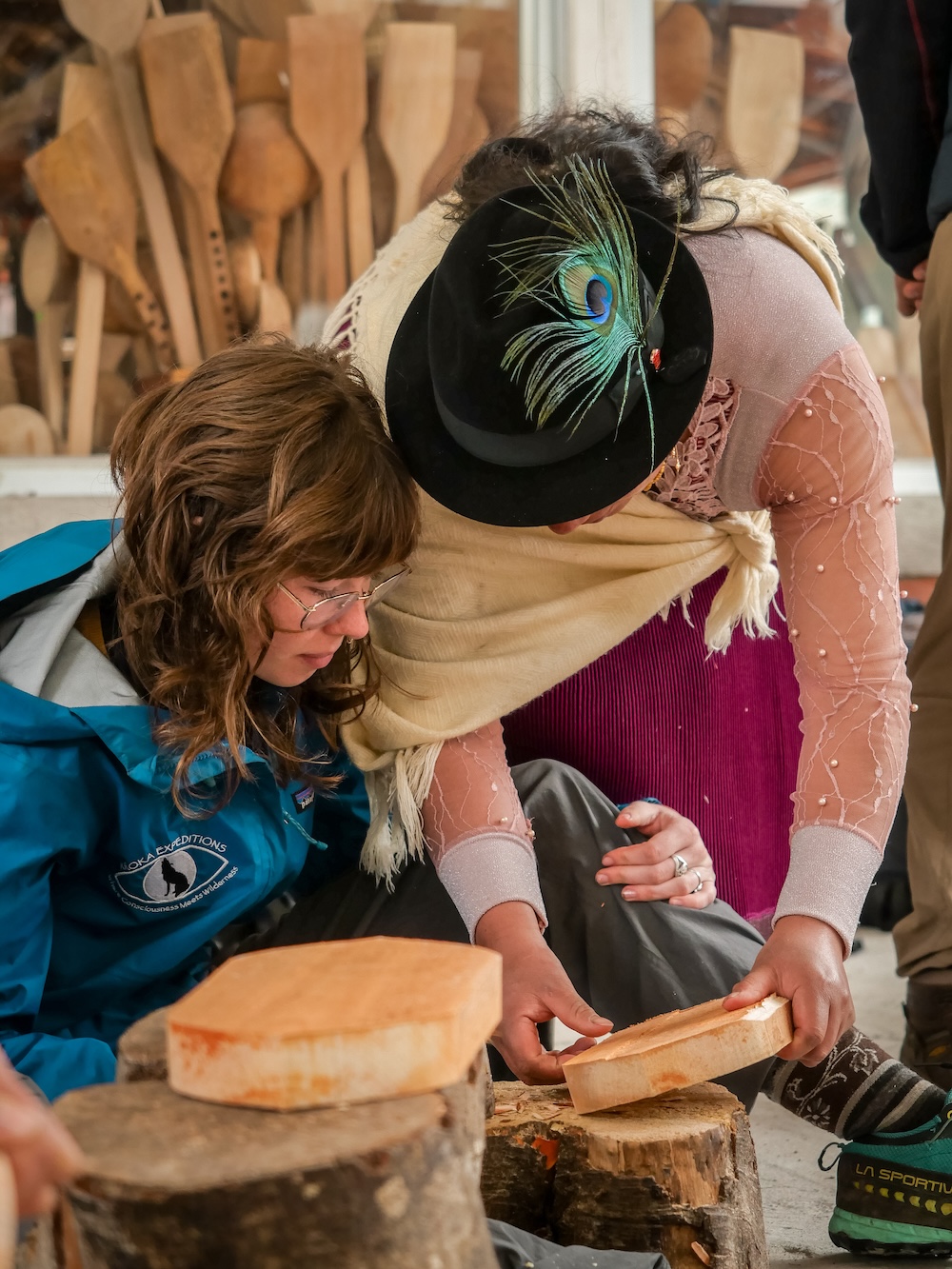
Alaya learning how to carve bowls
Lucia: After a long first day, we decided to hike all the way to the top of a nearby mountain. We follow a narrow road that curves around and up the mountain past garden plots and lively cows. At the top, the clouds have parted a little and we can see to the southeast where we came from and the northwest where we are going. It fills me with so much wonder and excitement for the journey ahead of us and pride in our strength and bravery.
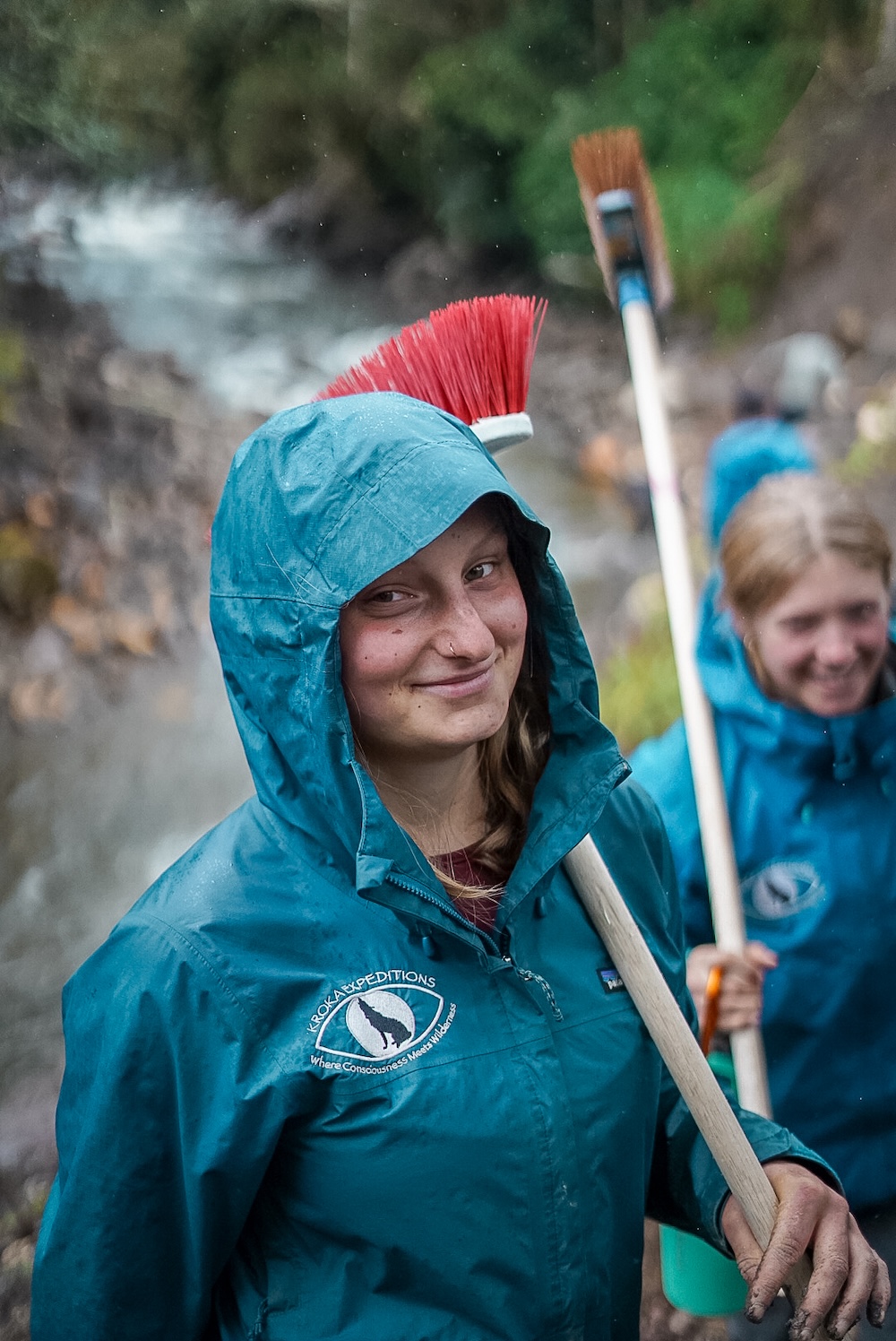
Lucia working on the trails with Solena
Alexa: It’s right after lunch, the clouds are rolling in and rain is coming, but we keep on pedaling, pedal after pedal. Tonight our goal is to make it to 4,000 m — the highest campsite yet! The clouds are low, creeping up behind us, threatening to engulf us fully. Just before we reach the top, we find a truck in the ditch. We help push it out, giving us the last burst of energy to reach our campsite.
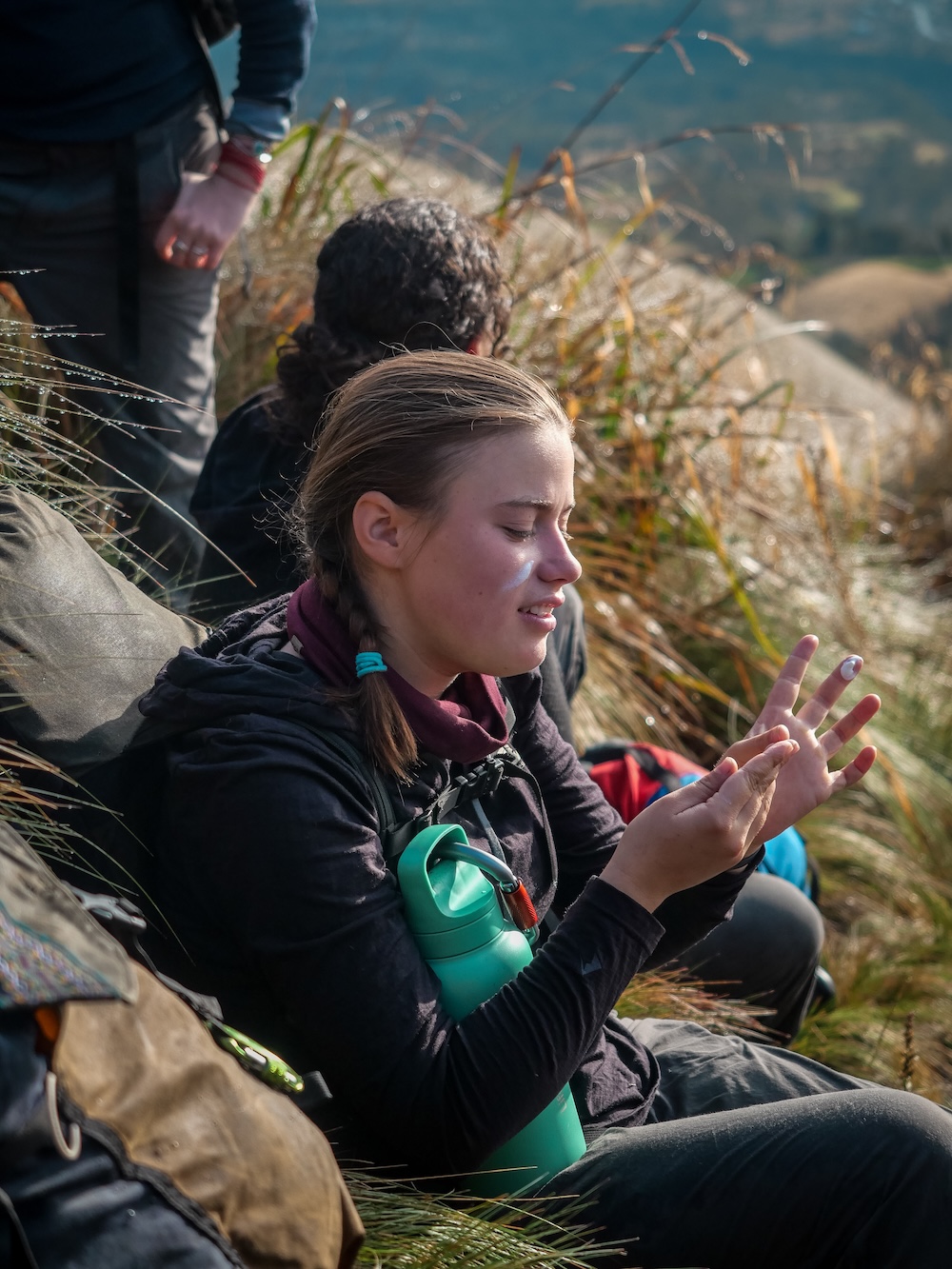
Alexa applying sunscreen during their hike
Wilcca: It’s beginning to turn dusk. I’m tired. We had just done 900 m in 11 km. The uphills were steep — you could barely keep the front wheel of your bike down. We’re on this hill in a circle with our eyes closed, a blind vote to either set up camp right there or push in the dark to the second camp — a cabin. I hear Lindsay say, “Okay, raise your hands if you want to set up camp now.” Silence. “Okay, raise your hands if you want to push forward.” I hear a flurry of rain jacket arms raising. I open my eyes — everyone wants to push. I get a second wind as we traverse rolling hills in the dark.
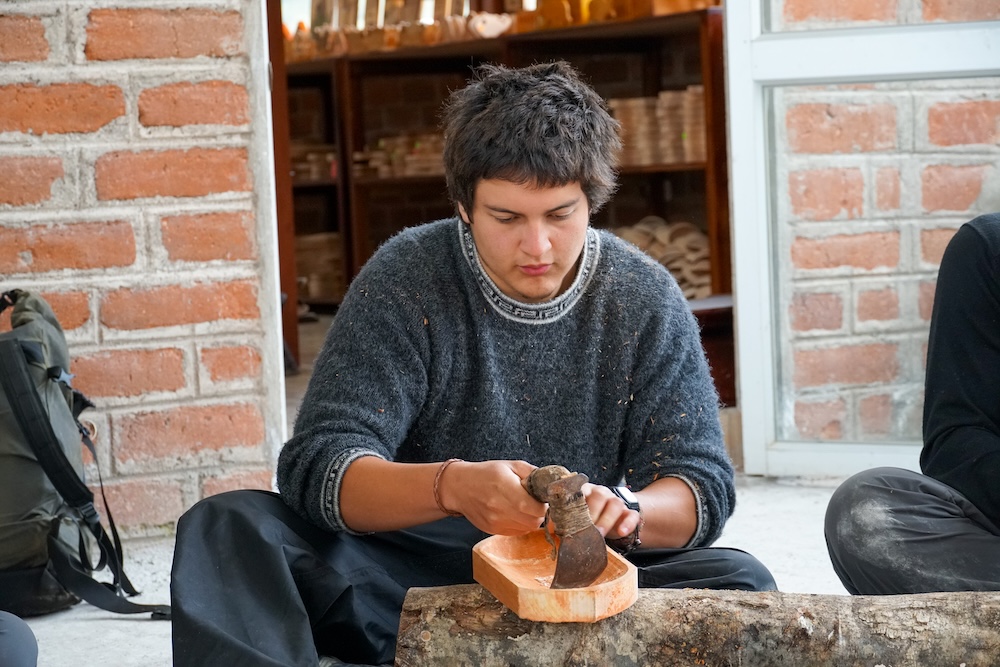
Wilcca learning how to make his bowl
Finn: We’re pushing through the night after a really hard day to get to the cabin, and we see Antisana on the horizon.
Lore: I’m pedaling and it’s almost 6:30 when I see the group pointing and smiling. I look back and there it is — Antisana covered by orange, purple, and pink clouds. The happiness and adrenaline rush through my body; I know this will stay with me as a lovely memory.
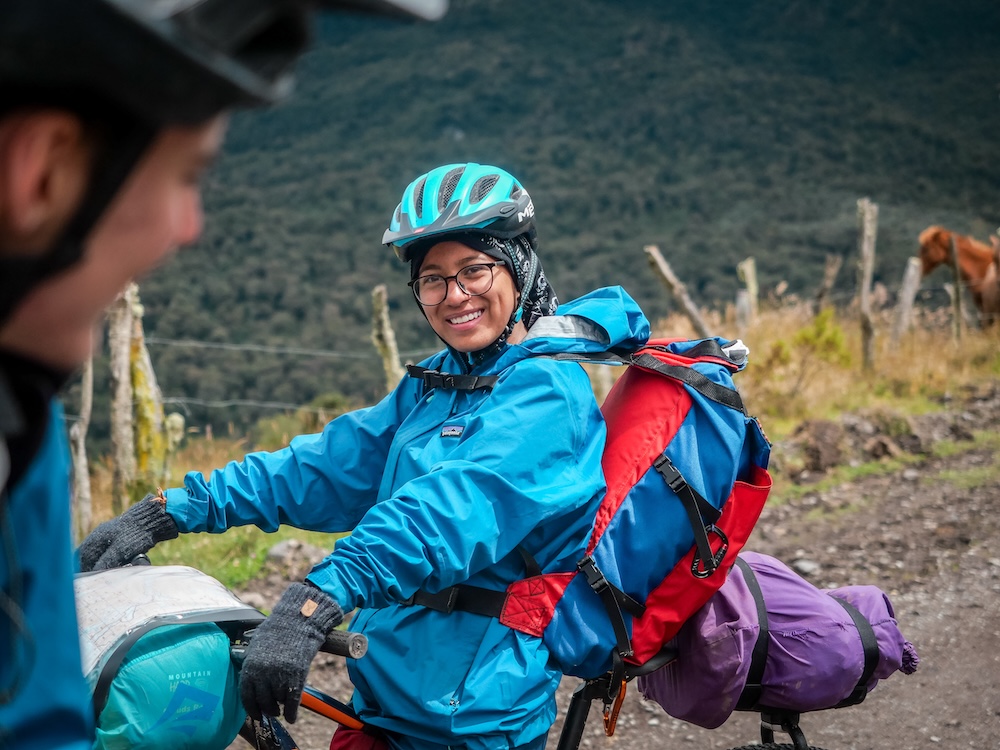
Lore
Clara: I’m pushing up a hill in the pitch black during our longest day yet. We are just a group of white headlamps cruising on bikes through Andean mountains. I’m leading the group — the responsibility of a good pace is mine, but I’m struggling myself. Lucia looks to me and says, “Wow, you’ve gotten so much stronger on these hills, Clara!” In this moment, the warmth of friendship and pride in myself override the hunger in my belly and soreness in my legs. I know this group will accomplish so much together — and we already have. Hasta el Antisana y más allá!
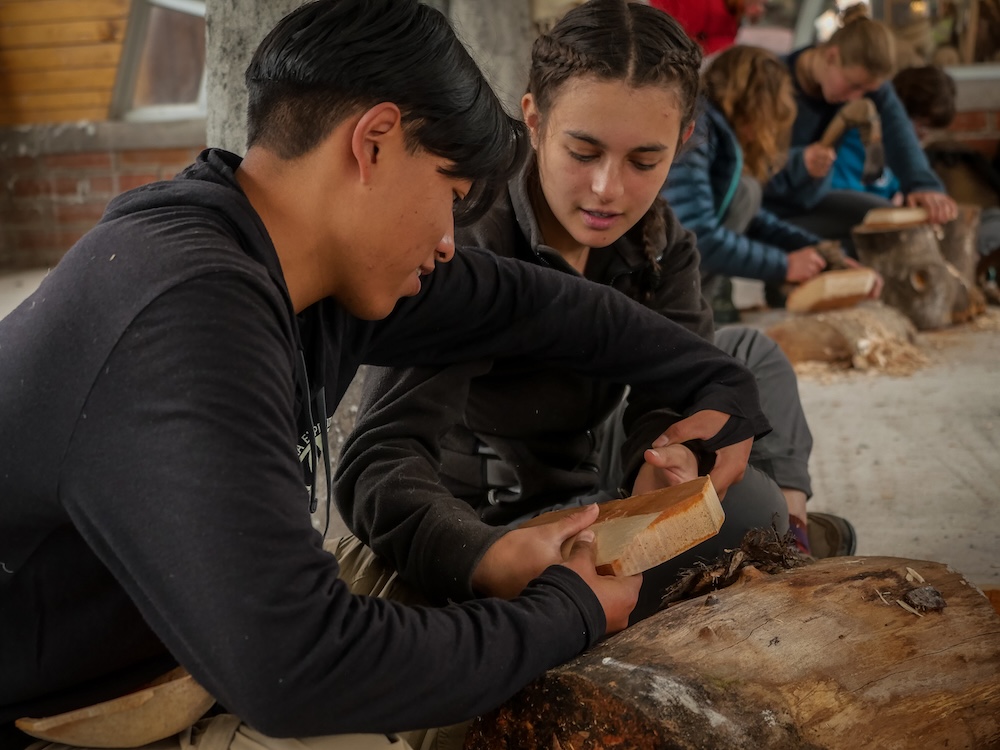
Jhordan and Clara working on their bowls
Oyacachi to San Clemente ~ Our final leg took us back into the mountains, with two long, difficult days of biking and a long morning on the final day. Refreshed by Oyacachi, we set out — our excitement for San Clemente motivating us.
We began with a dreaded 8 km steep and constant uphill, which turned out to be not all that bad with a slow, steady pace and interesting conversations. The route was gorgeous, taking us through windswept hills and along dusty, wildflower-lined roads. The sun, which had barely shown its face during our other days, remained out all morning, warming and inspiring us.
In the evening, we arrived at the small town of Pisambilla, nestled in the Andes. We made our camp in the school soccer field and played soccer with local kids before dinner. That night, for sit spot, we hiked up the hill and sat at the windswept top, watching lightning in the distance and Cayambe in front of us. The next day, some of us woke up early to watch the sunrise from the same point.
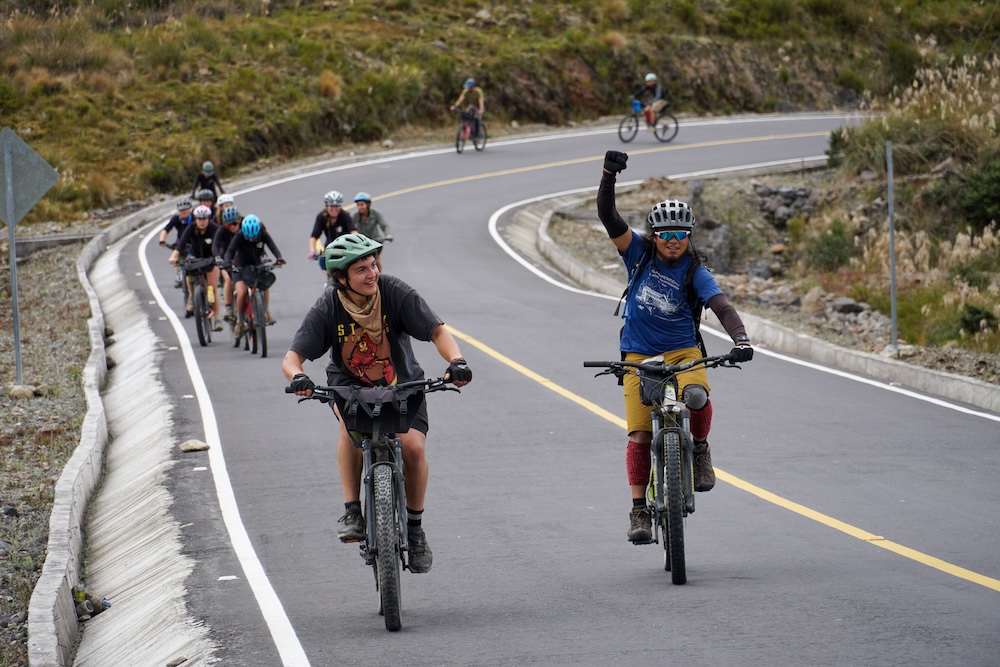
Reaching the end of said steep and constant uphill
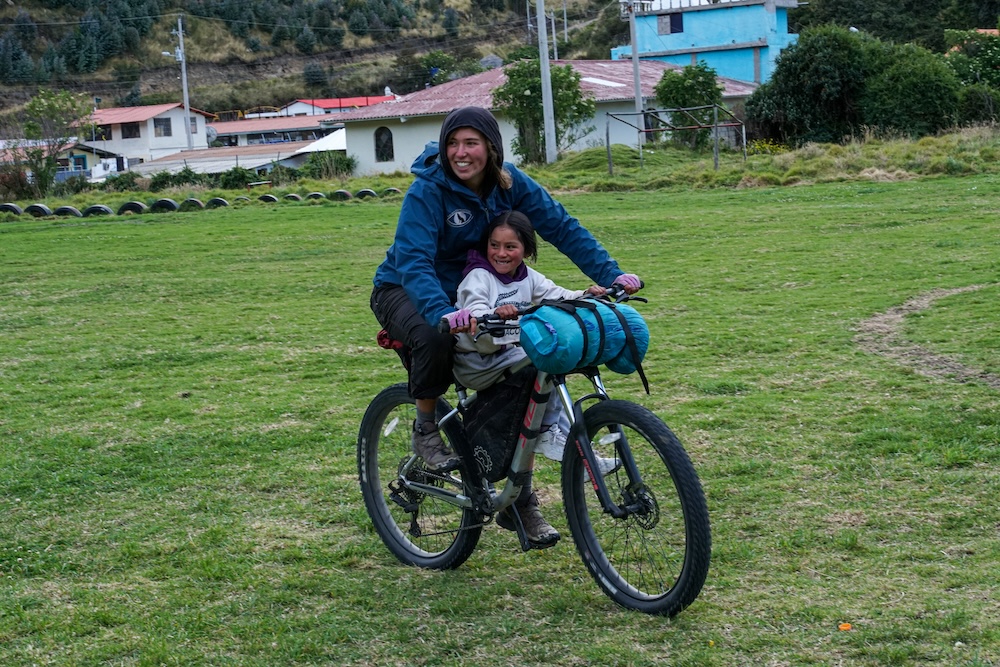
Dorothy giving her new friend a ride around the soccer field
Another long day of biking brought us through little mountain towns and up and down winding roads. In the afternoon, we took another vote to keep going and bike through the dark. Our way, illuminated by the soft glow of streetlights, led us to the town of Pisilla, where Roberto’s friend had a warm meal waiting for us. In total that day we biked 38 km.
Our final day brought us through small towns and paved roads, the smell of eucalyptus sweet in the air. On our way, we passed huge boulders and trees in the road — evidence of protests that are particularly prevalent in this area. For our final stretch, we pushed our bikes through cornfields and riverbeds before reaching the final cobbled road to San Clemente.
We were all sore, wet, dirty, and tired after 11 days and 180 km — but we were also so grateful for everything we experienced and learned from our time on expedition. At San Clemente, our families greeted us with a beautiful ceremony, welcoming us into their lives and the wonderful experiences that await us.
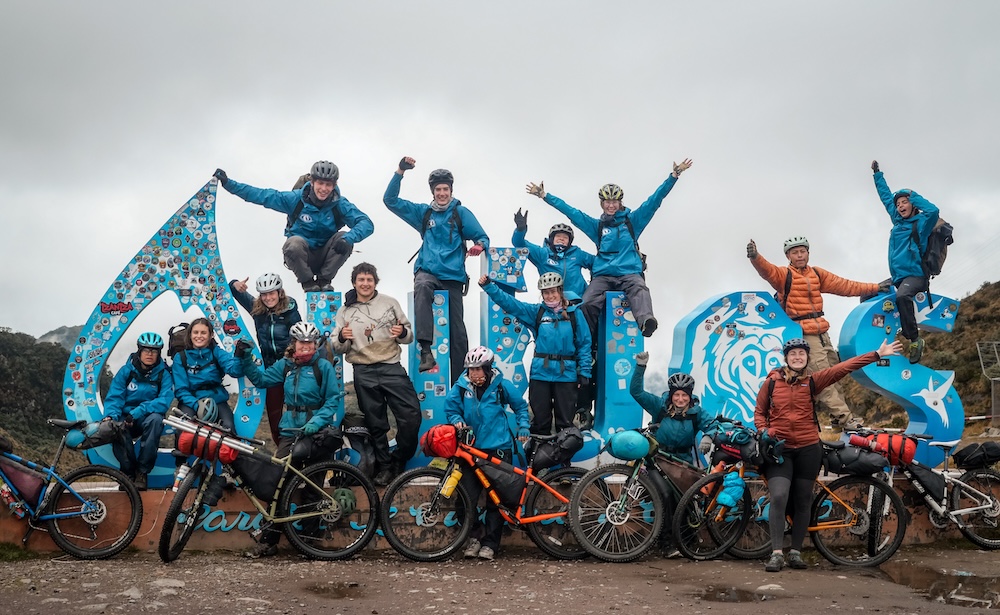
Reaching our highest point over 4000m!
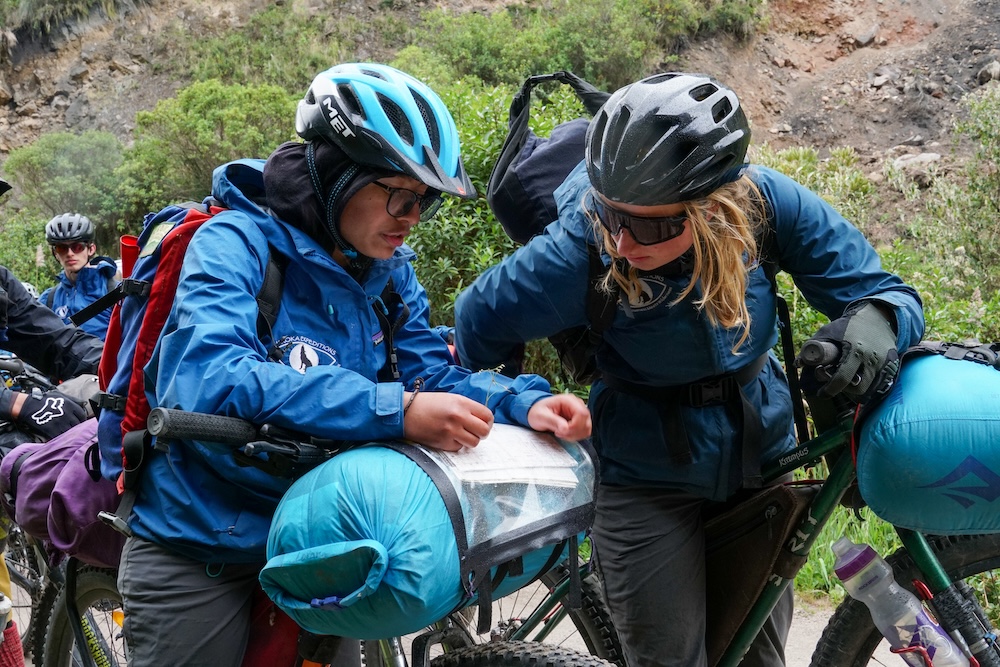
Lore and Lucia navigating us through confusing roads
Powerful moments for our group #2:
Davis: My legs are burning, my whole body aches, and my lungs are gasping for air. Then I see a little brown horse carrying a full family — a mother and her two young daughters. They’re each carrying a puppy. The family is smiling and waving in their colorful ponchos. I feel like I’m in a dream from a time long ago.
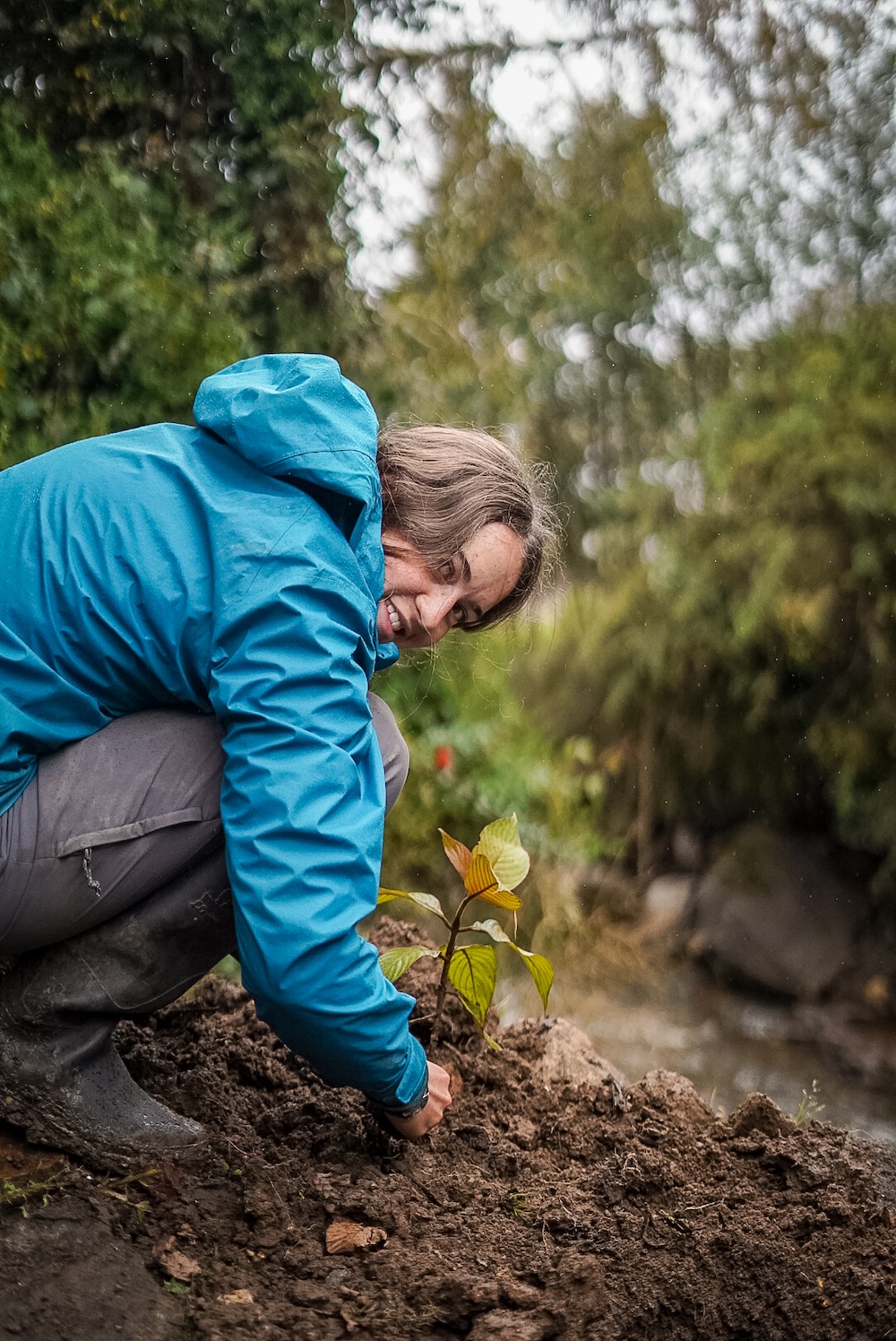
Davis planting trees
Bennett: After a long day of biking, we get to a small town below Cayambe. We set up camp in a soccer field, but then a few boys came over who wanted to play soccer. We play until the street lamps illuminate the field. After a good game, we go back to camp in the dark.
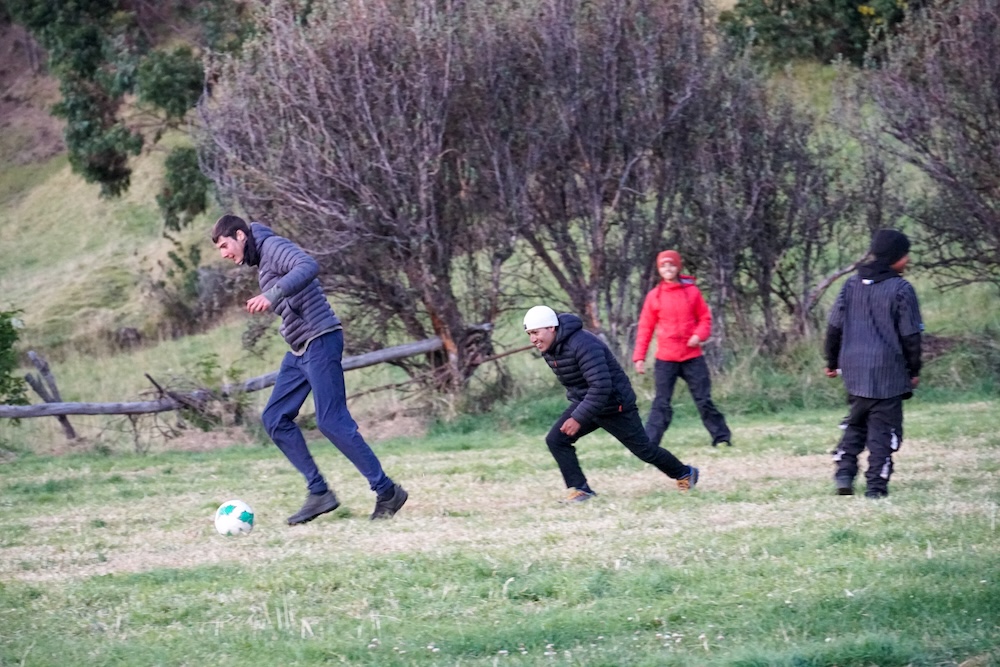
Finn with possession during the evening game
Dorothy: I’ve just woken up to the chilly downpour, and we are hiking single file up the steep hillside stretching up to the north of our camp here in the school soccer field. We cross the hillside shoulder, which opens a crystal view of the distant, snow-covered Cayambe and the nearby farms slowly waking for the day. I turn around, breathing heavily, and see the setting moon to the west, making way for the sun now just reaching over Imbabura to our east.
Solena: We’re close to our campsite for the night and I’m biking by the orange light from street lamps when there’s a big flash of lightning and suddenly all the street lamps go out — it’s completely dark. We switch on our headlamps and Bike Pod Two (the best pod) keeps cruising along while singing “Am I a Man or a Muppet” from the Muppet Movie.
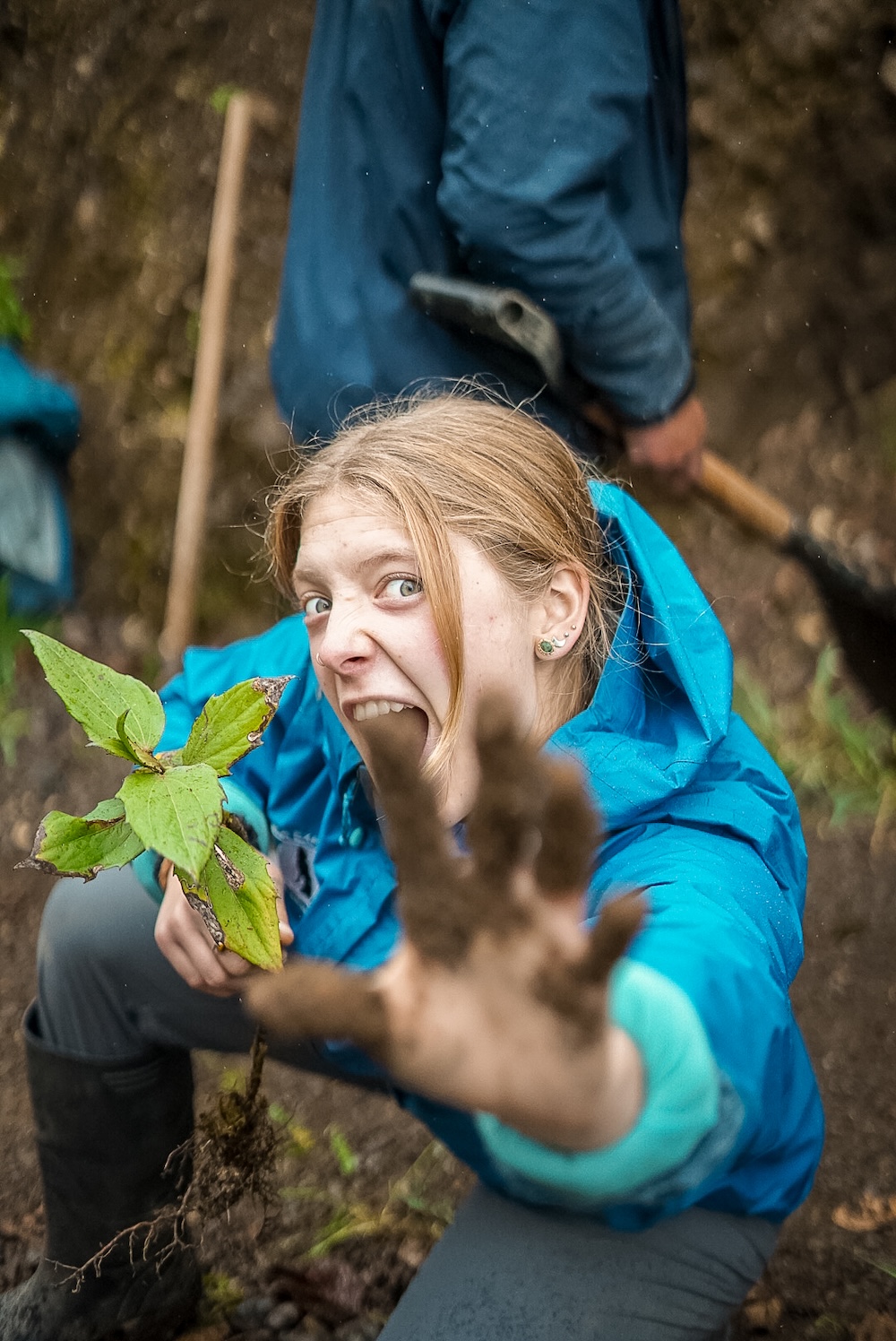
Solena planting trees
Grace: There they are — the San Clemente family all lined up, clapping and smiling, the kids shouting and laughing, dogs playing. They welcome us with open arms into their community while we each ride single file through the two lines of people we will get to know so well. I take in all my surroundings — the families’ beautiful outfits, the sprinkles of rain hitting my cheeks, the smell of mud and plants. I’m so excited for the next journey to come.
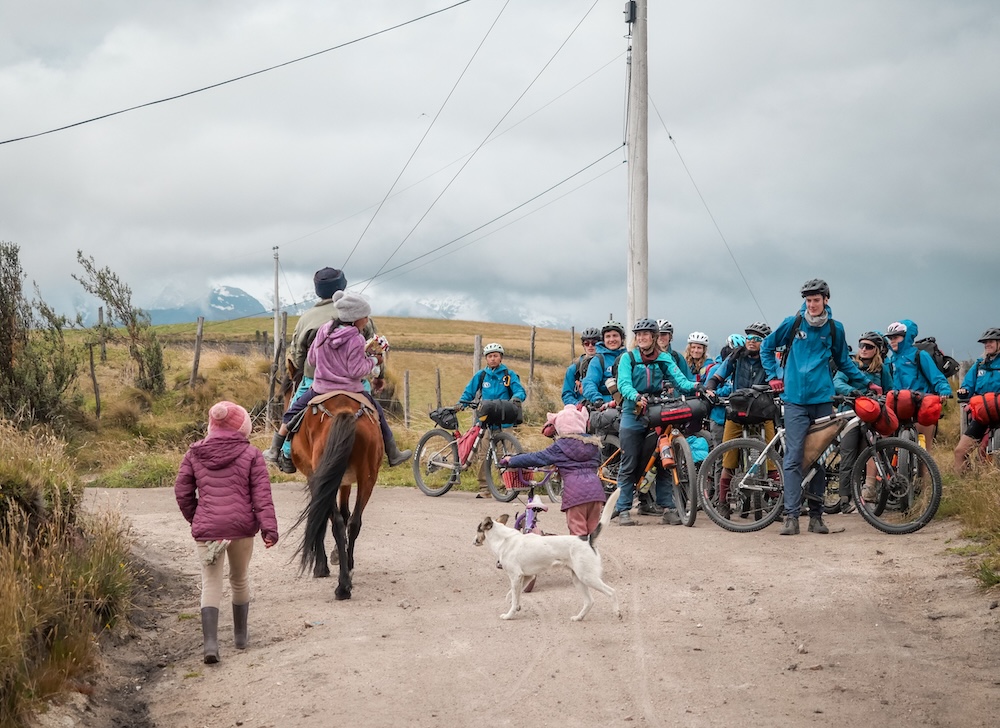
Meeting families on horses
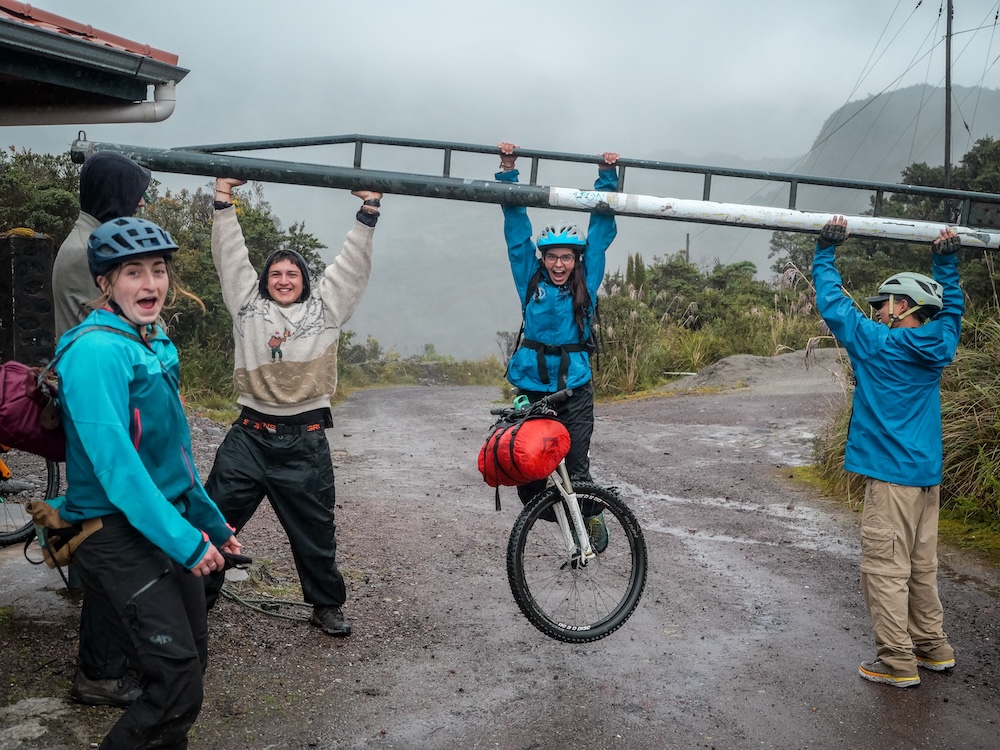
Grace with the grip; Wilcca & Jhordan doing the lifting
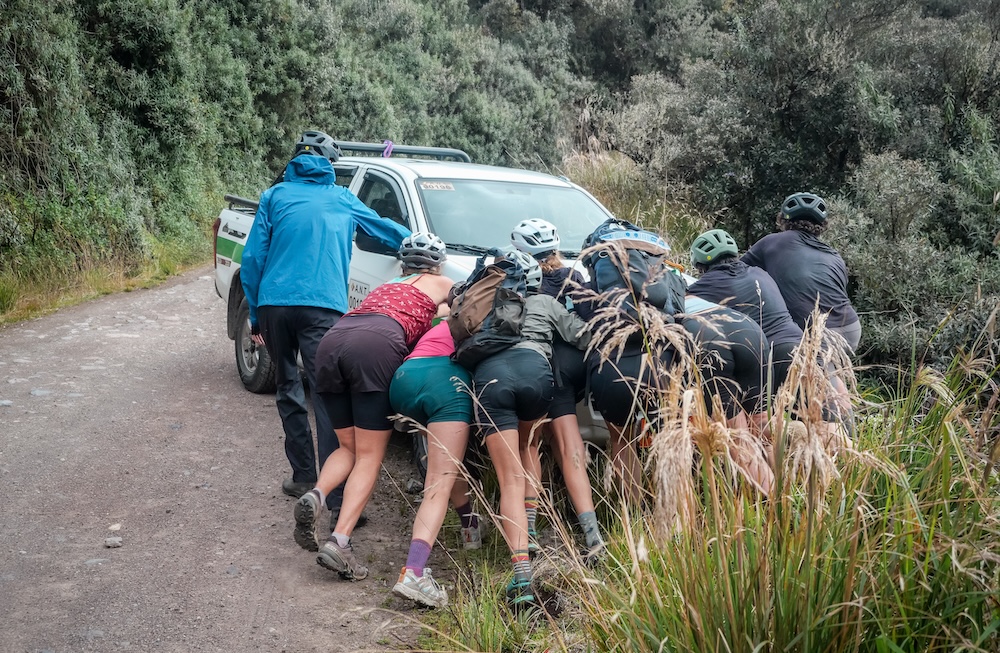
Working together to push the truck out of the ditch
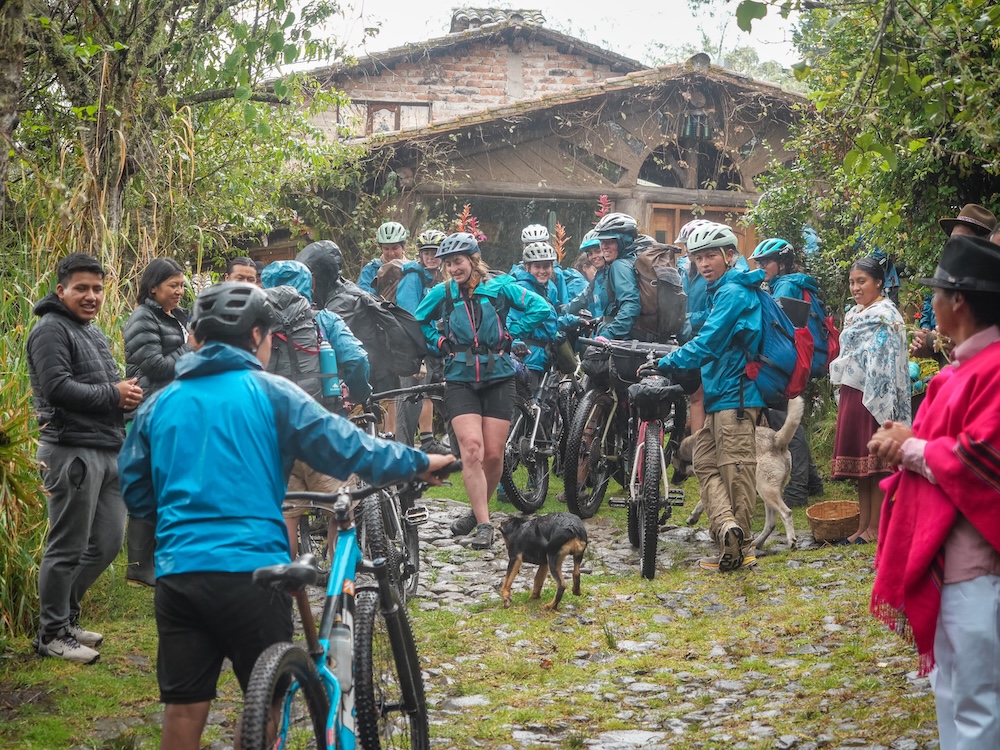
Families welcoming us
San Clemente ~ The San Clemente homestays are a deeply important part of the semester. While much of our time is spent expeditioning or at Palugo, this time is an incredible opportunity for us to connect with the people who live here, practice our Spanish, connect with the culture and traditions, and immerse ourselves in the way of life.
San Clemente is an Indigenous Quechua community on the outskirts of Otavalo and below the mountain Imbabura. The original name in Kichwa means “Cold House.” San Clemente is a religious name from the history of haciendas and oppression. The people of San Clemente organized and gained their own land, creating a system of different responsibilities so that everyone can support each other. They have worked hard to keep their culture alive and strong. As a way to create livelihoods in San Clemente, they began hosting tourists and students and sharing their traditions and ways of life.
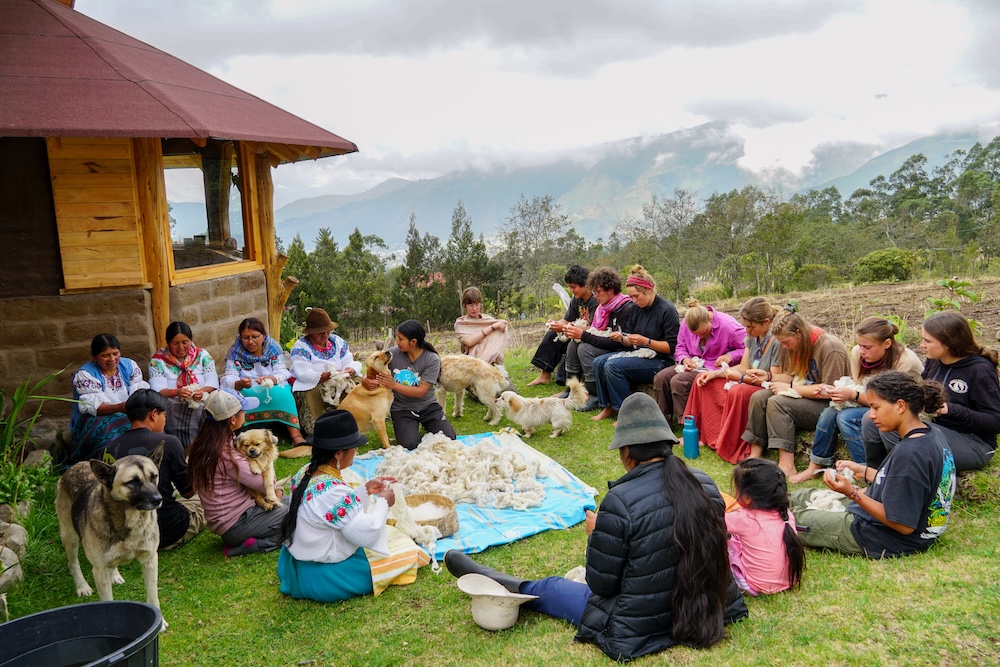
Everyone and their homestay mamas pulling out the dirt from the wool
In San Clemente, we were divided into pairs, after a beautiful welcoming ceremony, and joined our host families. We would be spending the next ten days living and eating with our families and going to classes during the day. We were divided into pairs based on our Spanish levels to make sure we were all pushing ourselves.
With our new brothers and sisters, we had our first meal with our host families. Each family was so kind and welcoming and made us feel at home in their house and in their family. The language barrier was difficult — many people reflected that they felt unable to connect as deeply as they wanted. Sometimes meals were awkward, with the feeling of being unable to start conversation. Sometimes communication was complicated and confusing, and the constant immersion in a new language could be very draining.
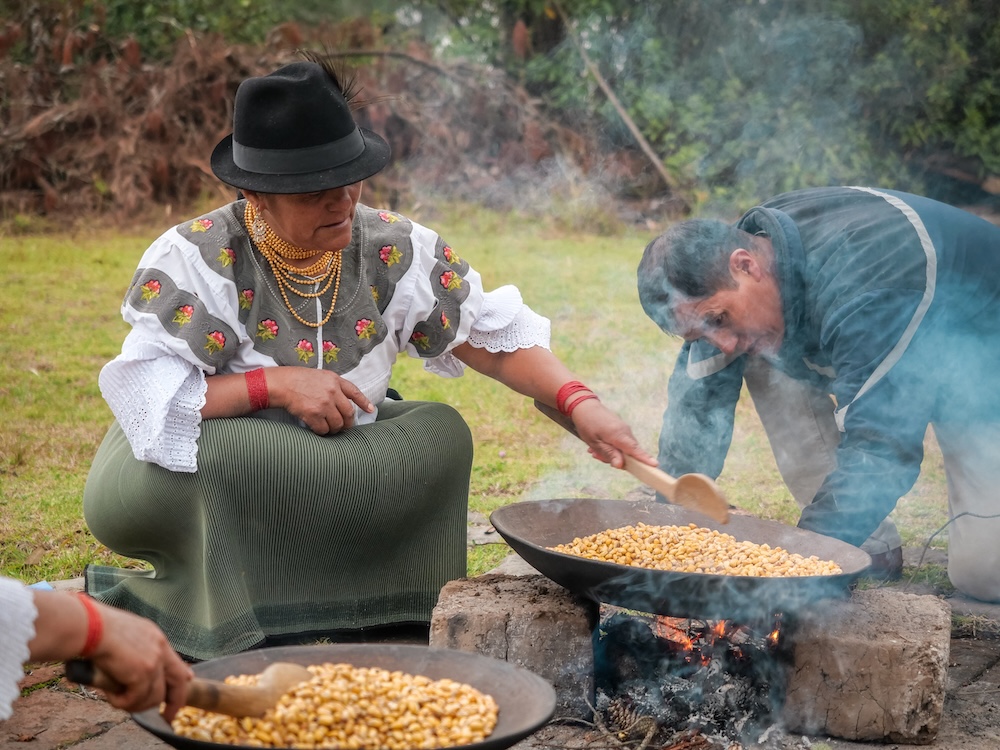
At the same time, it was incredible to be immersed in the language. Along with the Spanish classes, the practice with our families improved our Spanish greatly. We found ways to communicate with gestures, laughter, and actions. Each day we were reminded that connection is more than language. Getting to know our families and their rhythms and traditions was incredible. Each day we learned so much — whether it be about beekeeping, herbal medicine, history, or their daily lives. We gained so much connection with our families and the San Clemente community, and we feel so much love and gratitude toward the people who welcomed us.
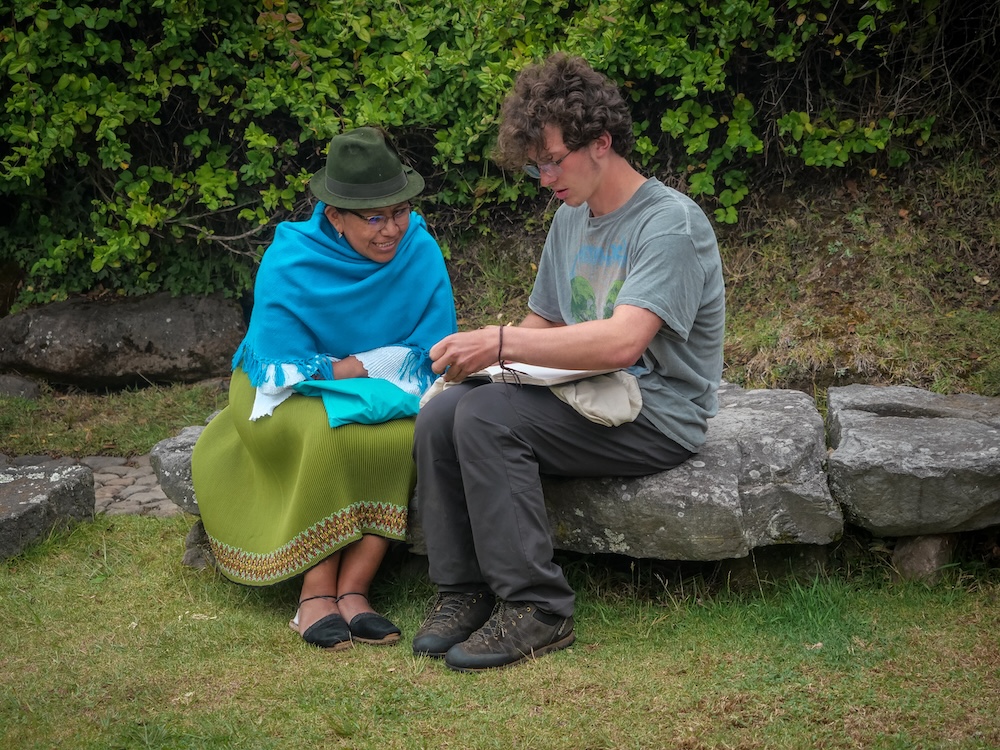
Bennett learning how to embroider from his homestay mother
Spanish Classes ~ During our time in San Clemente, we had Spanish class with our incredible teacher Katty. We learned basic vocabulary and grammar to give us a foundation and help us communicate with our families. We played lots of games and practiced short conversations. More advanced students worked on more challenging assignments, spending mornings working on projects with Inti (one of our host dads) and speaking Spanish. Meanwhile, Lorena and Jordan had English lessons with Rapha and Lindsay. I can say with confidence that we all improved our Spanish and English significantly!
A few favorite spanish and Qichua words learned:
Spanish
Nano – “bro”
Chevere – cool
La tormenta – storm
Quetua
Alipacha – delicious
Mashi – friend
Al Pungo – good morning
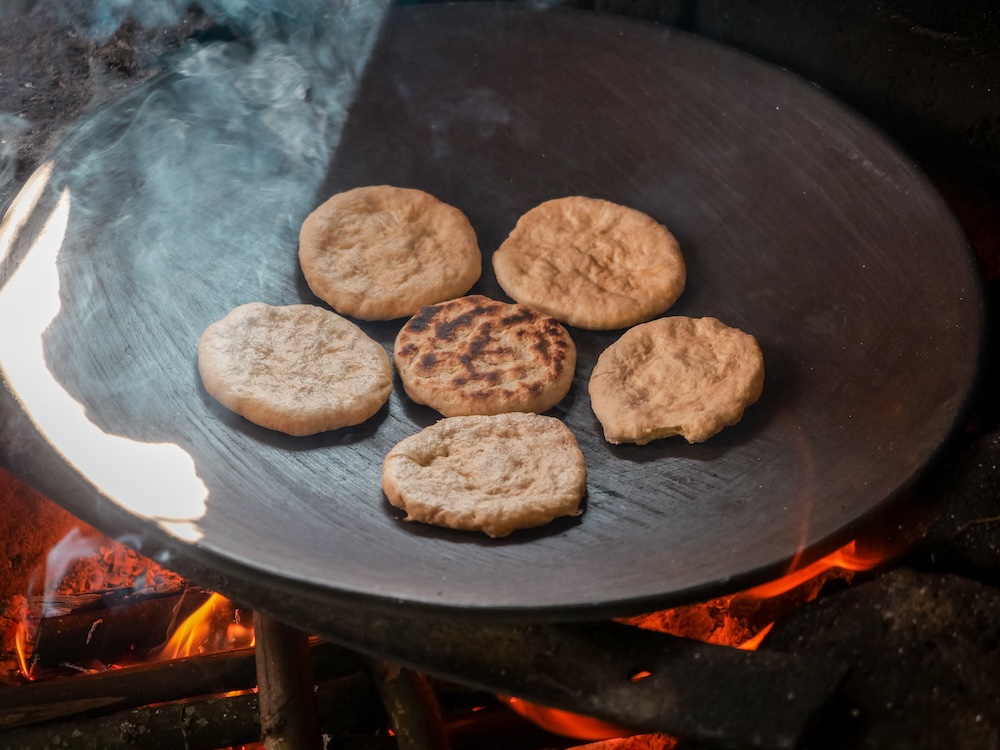
Crafts ~ Embroidering is an important and traditional craft here in San Clemente. The women wear beautiful embroidered blouses and also sell their embroidery as a livelihood. We each got a blank white shirt to design and embroider with beautiful and unique designs. We thought about what colors and symbols we wanted to include and then drew our designs onto the shirts. With help from our host families, we learned embroidery techniques and stitches and worked on the shirts in our free time. The completed shirts are incredible, and we will wear them for our graduation in Palugo.
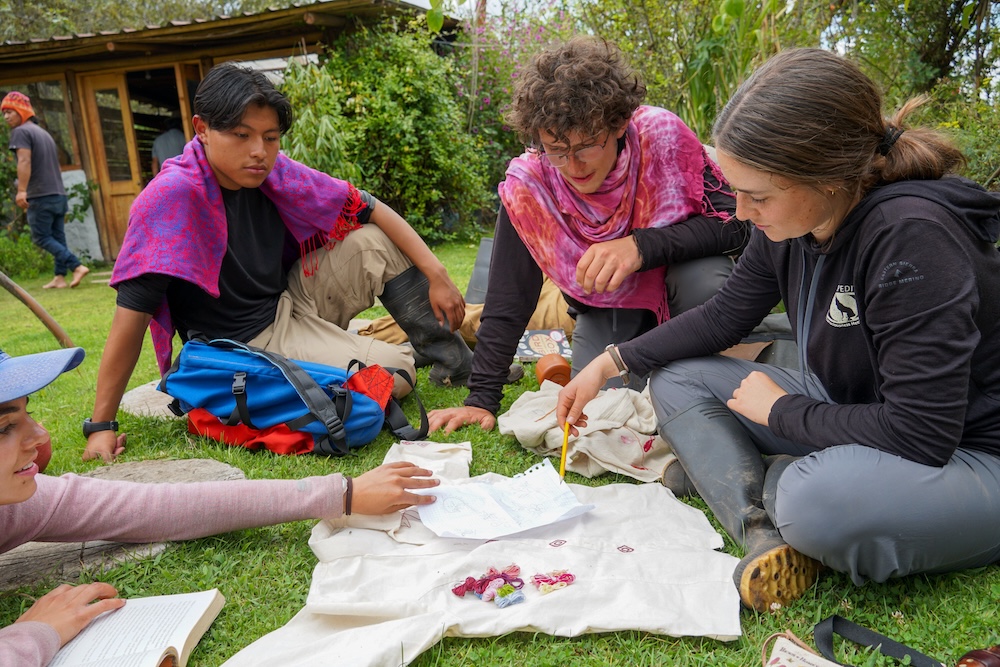
Designing our shirts!
The second craft we worked on during our time here was wet-felted wool hats with Fernanda! We learned about the work it takes to go from sheep to finished hats and worked with Fernanda’s family and our host families to clean the wool and then felt the hats. To make the hats, we first laid out the wool, then added hot water and soap, massaging the wool to felt and shape it. Finally, we had the option to add decorations with colored wool or embroidery. Each hat turned out uniquely beautiful and fun, and we deeply appreciate everyone’s work to make this project happen!
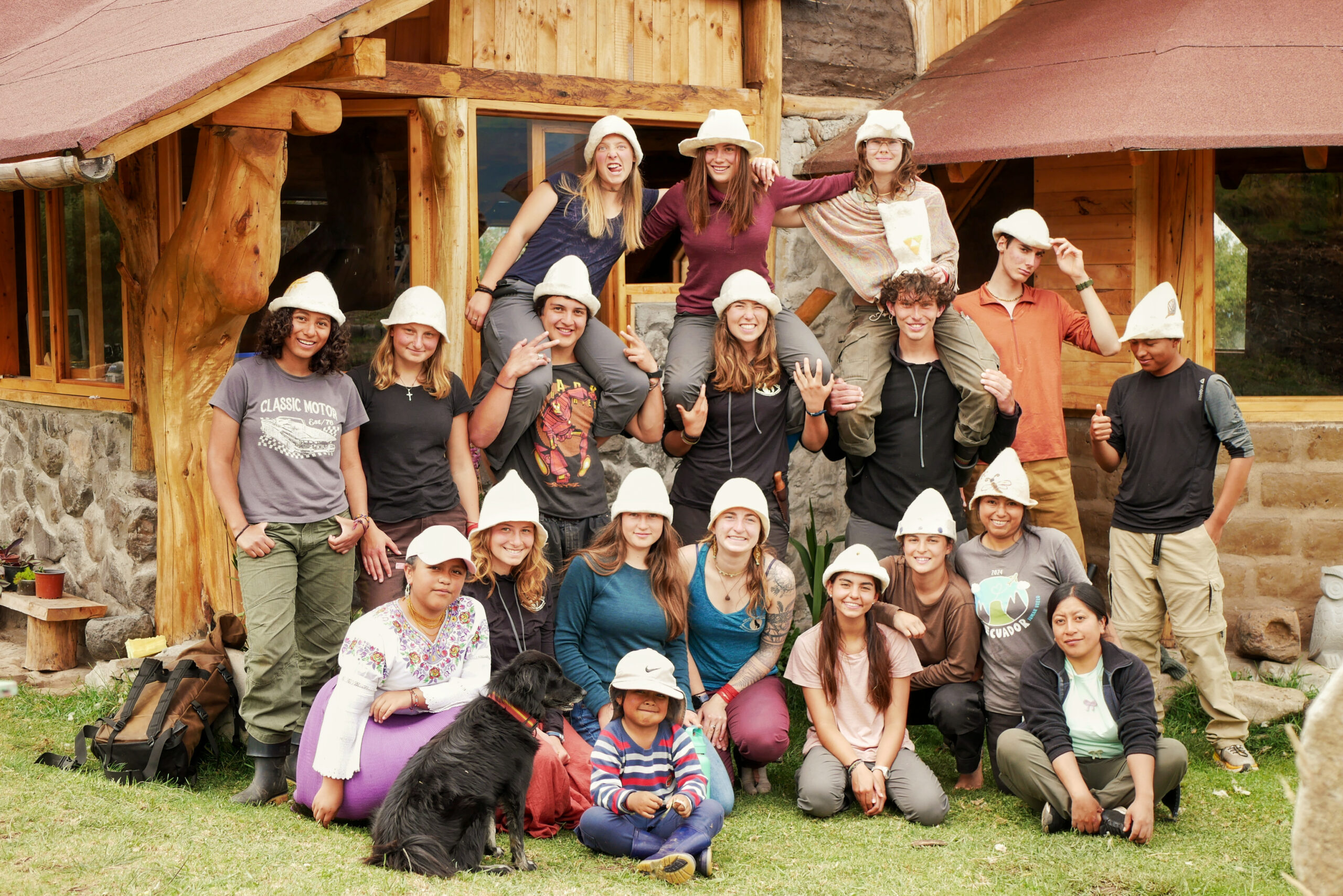
Everyone with their hats
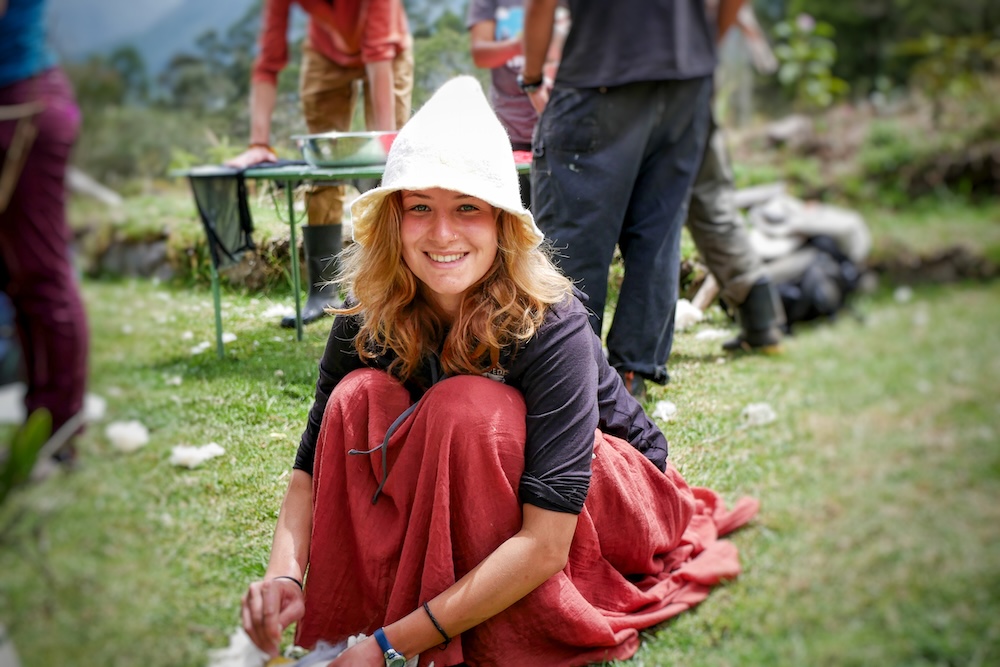
Ella with her gnome hat
Classes ~ We had two classes while we were here about the culture and history of San Clemente. With Eddie, we learned about the history of the haciendas and the abuse in San Clemente, and how the people organized and came together to create their own systems and responsibilities.
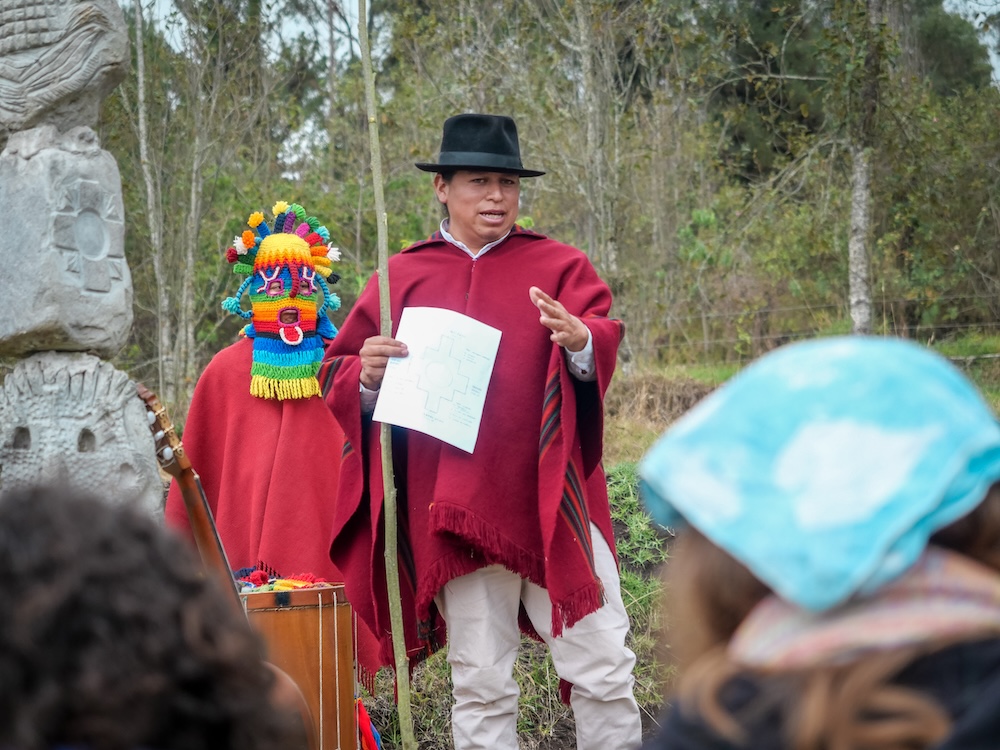
Tupac teaching us about the seasons and community
With Tupac, we learned about the solar calendar and the four seasonal celebrations that are based around the solstice, equinox, and harvest cycle. The resilience and strength of the people and culture here is incredible.
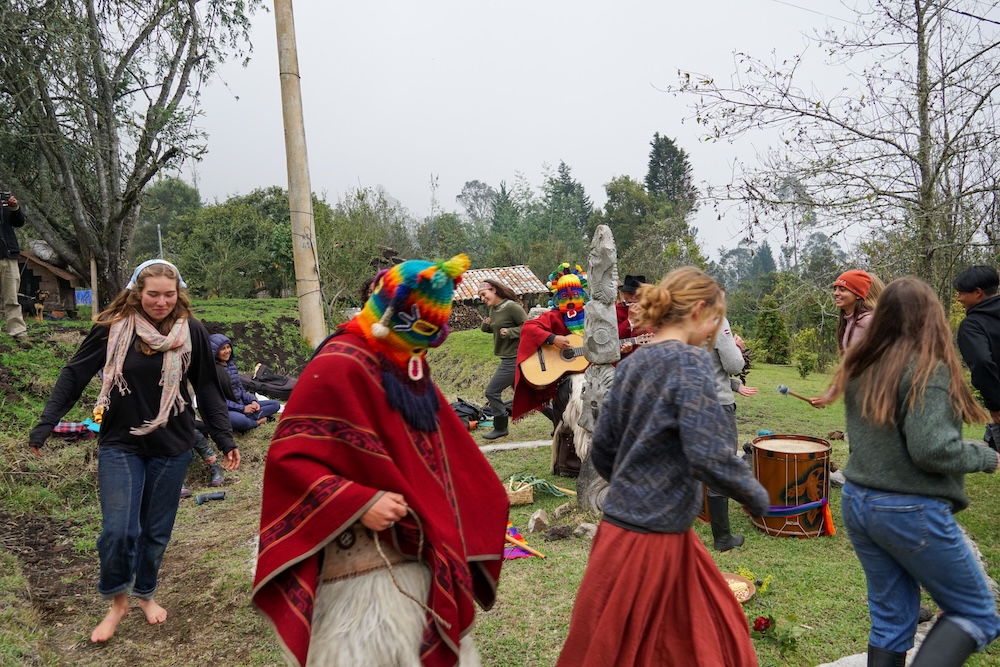
Dancing to celebrate the seasons
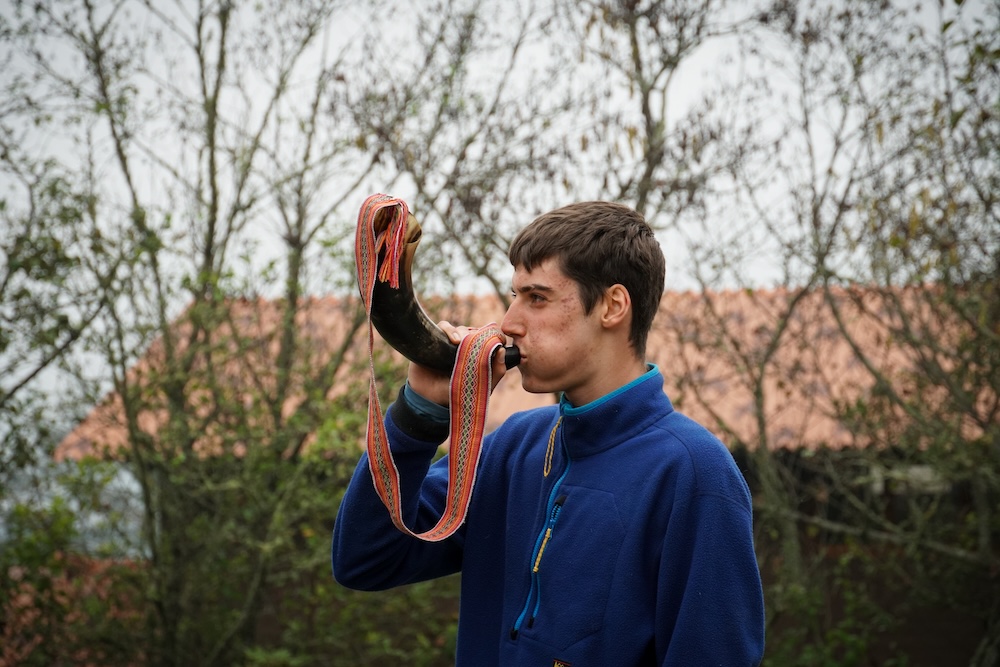
Finn learning how to blow the horn
Mingas ~ A minga is a time for the community to come together and work on a project. During our time in San Clemente, we participated in two mingas. The first was repairing a section of the stone street. We removed the old rocks and brought up more stones from the riverbed, then replaced them to create an even surface.
The second minga was planting corn, beans, fava beans and later trees. We learned how the plants work together to grow — the beans climbing up the corn, and the fava beans protecting both the corn and the other beans at the base. We walked along the rows, planting first the corn, then the beans.
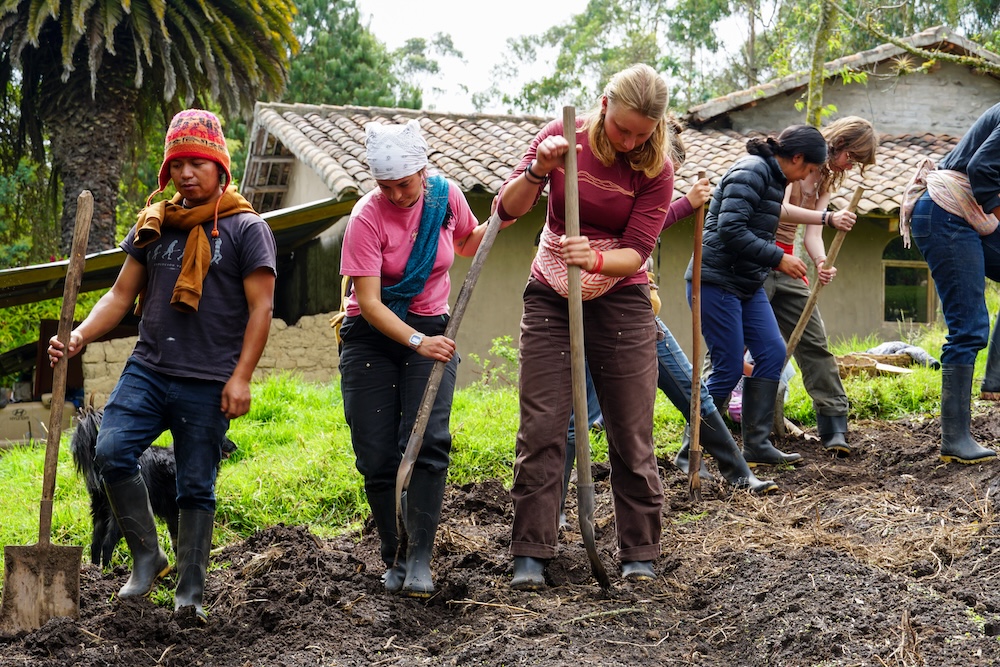
Planting seeds
Hiking Imbabura ~ San Clemente sits at the base of the inactive volcano Imbabura. On October 14th, we woke up at 3:30 a.m. and ate a quick breakfast before taking a bumpy truck ride up the hill to the base of the mountain with our instructors and locals from the village who supported us on the hike. As the sun began to rise, we set off with our loaded backpacks up the steep grassy slopes. From the mountainside we could see Imbabura and the surrounding peaks spread out before us. Unfortunately, some of our group began feeling sick and had to turn back.
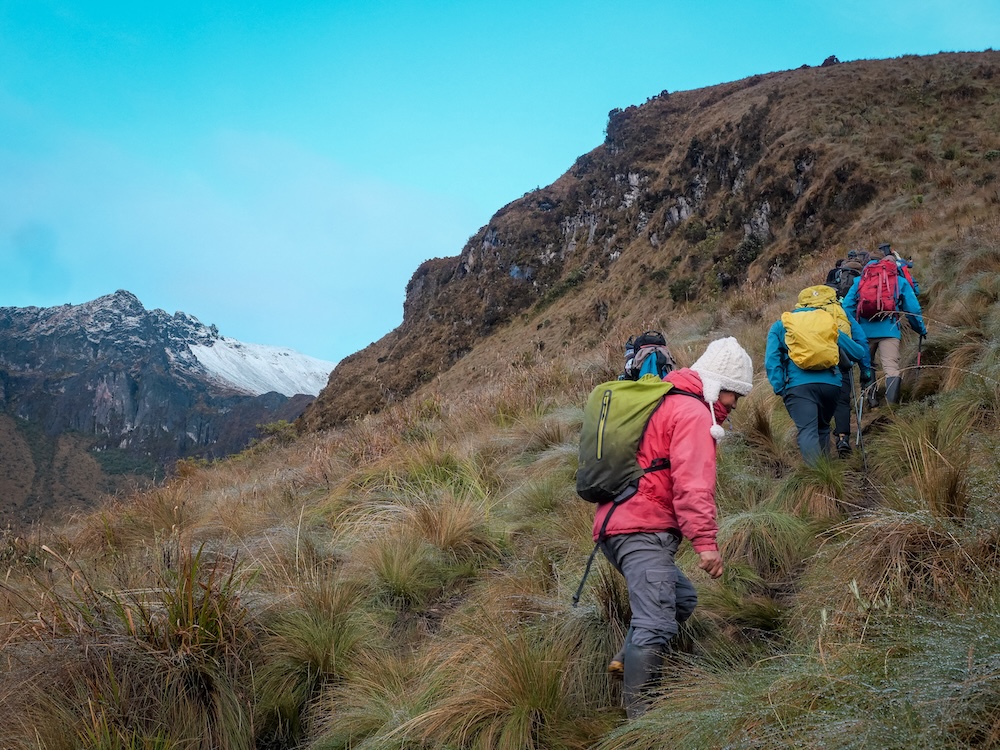
As we got higher, the grass turned to rocks and high-altitude flora, and the clouds surrounded us in all directions. In one section, we used ropes and harnesses for the more technical scrambling. It wasn’t vertical climbing, but we were definitely using all four limbs!
In the early afternoon, we reached 4,550 meters above sea level. This would be our summit for the day, as the altitude was beginning to affect us all and we needed to save energy for the descent. After a delicious lunch, we made our way down and returned home in the late afternoon. We were so grateful for Inti, Eddie, Tupac, and Vladdy for hiking with us — and to Imbabura for the incredible experience.
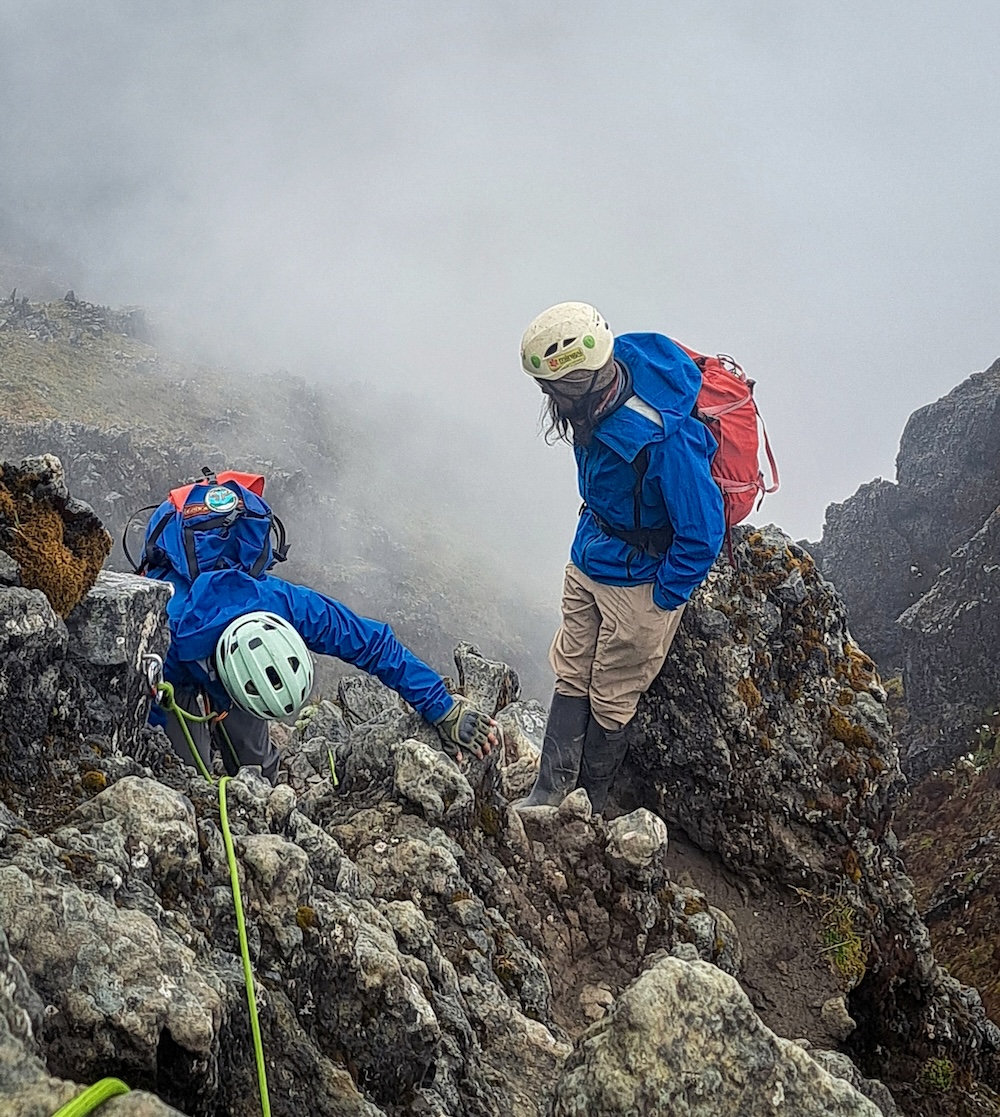
Scrambling up the rocks
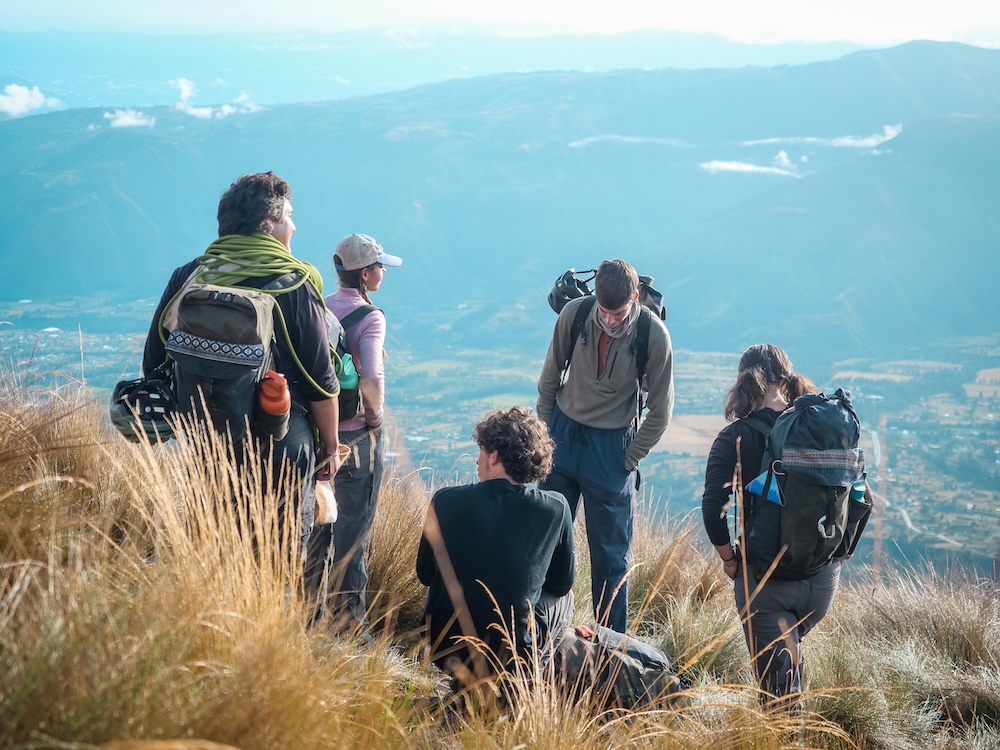
Mini Otavalo ~ Because of the protests, we were not able to go to the big market in Otavalo. We were disappointed because we were excited to buy gifts and souvenirs for ourselves and our loved ones. However, Roberto and his brother Geova worked to set up a “Mini Otavalo,” with local crafters who brought pottery, fiber arts, leatherwork, jewelry, and artwork. It was really fun, and we all found something we loved. In addition, it was beautiful learning about the families’ crafts and being able to support them during this difficult time.
Celebration and Goodbyes ~ Our ten days in San Clemente went by so fast. Before we knew it, it was our final full day, and we were packing up our bags for the next expedition. To celebrate our experience and say goodbye, we wore beautiful traditional clothing and shared a meal and ice cream with our families. After dinner, local musicians played music, and we danced together around a bonfire. We shared a few of our own songs and ended with one big traditional song and dance.
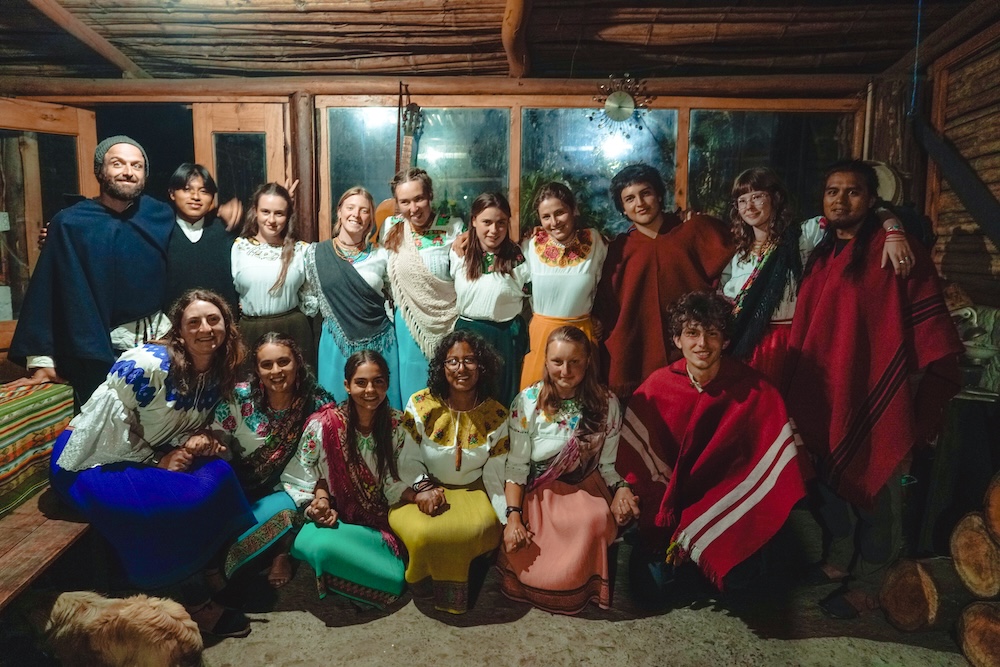
Everyone in traditional wear our last night
It was a wonderful night of festivity, gratitude, and joy. Music is such a powerful thing — it reaches between culture, language, and experience, connecting us all to the earth, each other, and ourselves.
The next morning, we woke early and said farewell to our families with a small ceremony where we shared appreciations, memories, and some joyous tears. Our families gave us bracelets for protection and good energy for our travels ahead. We were so sad to go, but it was a beautiful morning filled with many happy tears. We are all taking so many lessons with us as we continue on our journeys. The intention, patience, warmth, and connection of life here stood out to us clearly and powerfully.
Each family was so incredibly welcoming and generous, and we are infinitely grateful for our time in San Clemente.
Departure from San Clemente ~ Leaving San Clemente didn’t go quite as planned. The idea was to take a bus from San Clemente straight to Avispero, but because of the roadblocks from the protest, the bus couldn’t reach us. Monday morning we set out from San Clemente with all our personal gear and everything we needed for Avispero packed into backpacks and stuff sacks. We started by piling into two trucks and following back dirt roads, but soon came to our first eucalyptus tree across the road — and so, we started walking. The hot sun beat down and our bags dug into our shoulders, but it felt like an adventure, almost like a mini expedition!
Not only that, we finally got to witness the protests we had been hearing and learning about from our host families and instructors. It felt very important to put a face and image to what we’d been discussing — like we were finally seeing the real situation with our own eyes. Everyone at the roadblocks was very kind and friendly, letting us through on foot without question.
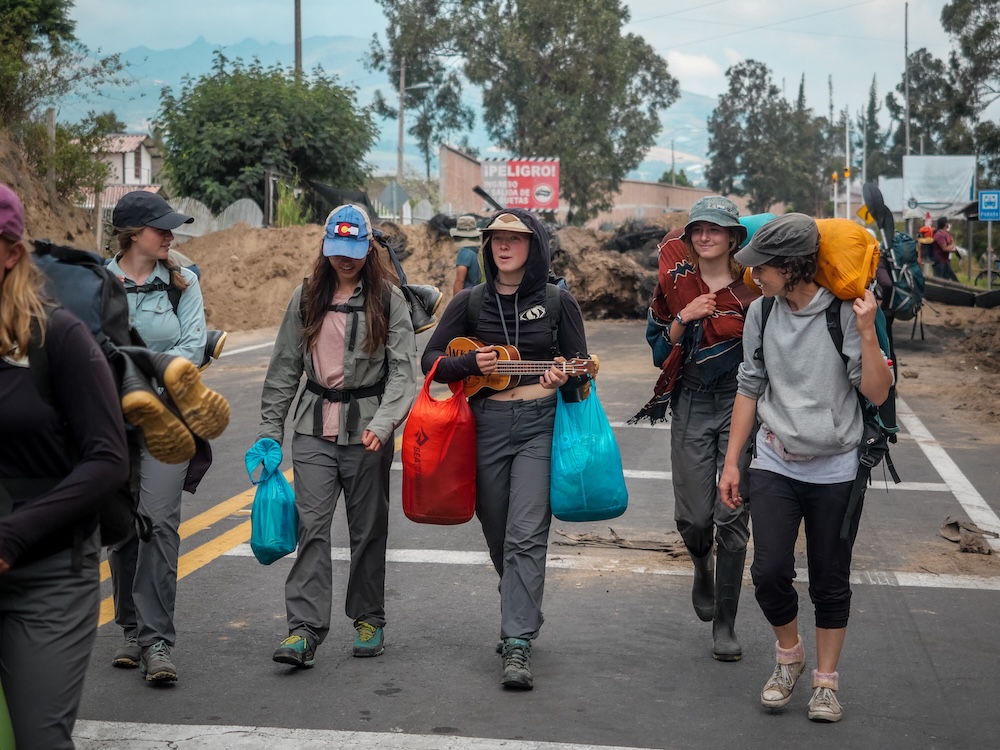
Solena and peers singing for peace
At the end of the day, we finally got onto another set of trucks that took us to the home of a former Nahual/Palugo student, where we were fed a delicious meal and given tours of their huge, beautiful flower gardens and bees.
The next morning we woke up early, at 4:30, to eat breakfast and then meet another round of trucks at 5:30. The trucks took us to the first roadblock, where we started walking again. It felt almost like something out of a dystopian novel — walking on abandoned highways for kilometers on end. The walk was long, but we stopped a few times for bread or biscuits with caramel! We were certainly a funny sight: a huge group with our homemade backpacks, brightly colored stuff sacks on our shoulders, and our rain boots strapped to our bags. One backpack even had two boat paddles sticking out!
Toward the end of our walk, the ukulele was taken out, and we sang and played as we walked. At the final roadblock, we came upon a group of locals who, when they saw our instrument, eagerly asked us to play. Rafa played a couple of songs, and everyone — from both groups — danced and sang along. It was a beautiful moment, and we hope it brought a bit of joy to the people trying to make their voices heard.
At long last, we reached the Palugo trucks with Matias and Michael, who took us to the bus that was waiting to carry us to Avispero.
~
“I found the days of walking to be fun and insightful. It felt like we were seeing everything going on, and the feeling of walking on an empty highway is something I’ll probably never experience again. The moment when we played music at the blockage felt so warm and beautiful.” — Wilcca
“It was really inspiring to see so much action being taken, and getting to witness some of it. Everyone was so driven and dedicated.” — Solena
“It felt incredibly dystopian — nobody for miles, the big blockages of earth with piles of tires across the roads. It was so moving to see everyone standing up for their rights.” — Lucia
~
Thank you for tuning in again. Next, we travel to the Avispero cloud rainforest and the Amazon jungle, holding the beautiful memories of our time here in our hearts.
Until next time,
Your scribe,
Ella
A final note from Lindsay:
There are a lot of difficult things people are navigating all over the world right now. Watching this group travel through Ecuador with such curiosity, kindness, openness, and genuine respect for others’ civil rights has been deeply inspiring. They move through this country like a healing light — creating connection, understanding, and warmth wherever they go. It feels like exactly what the world needs right now.
